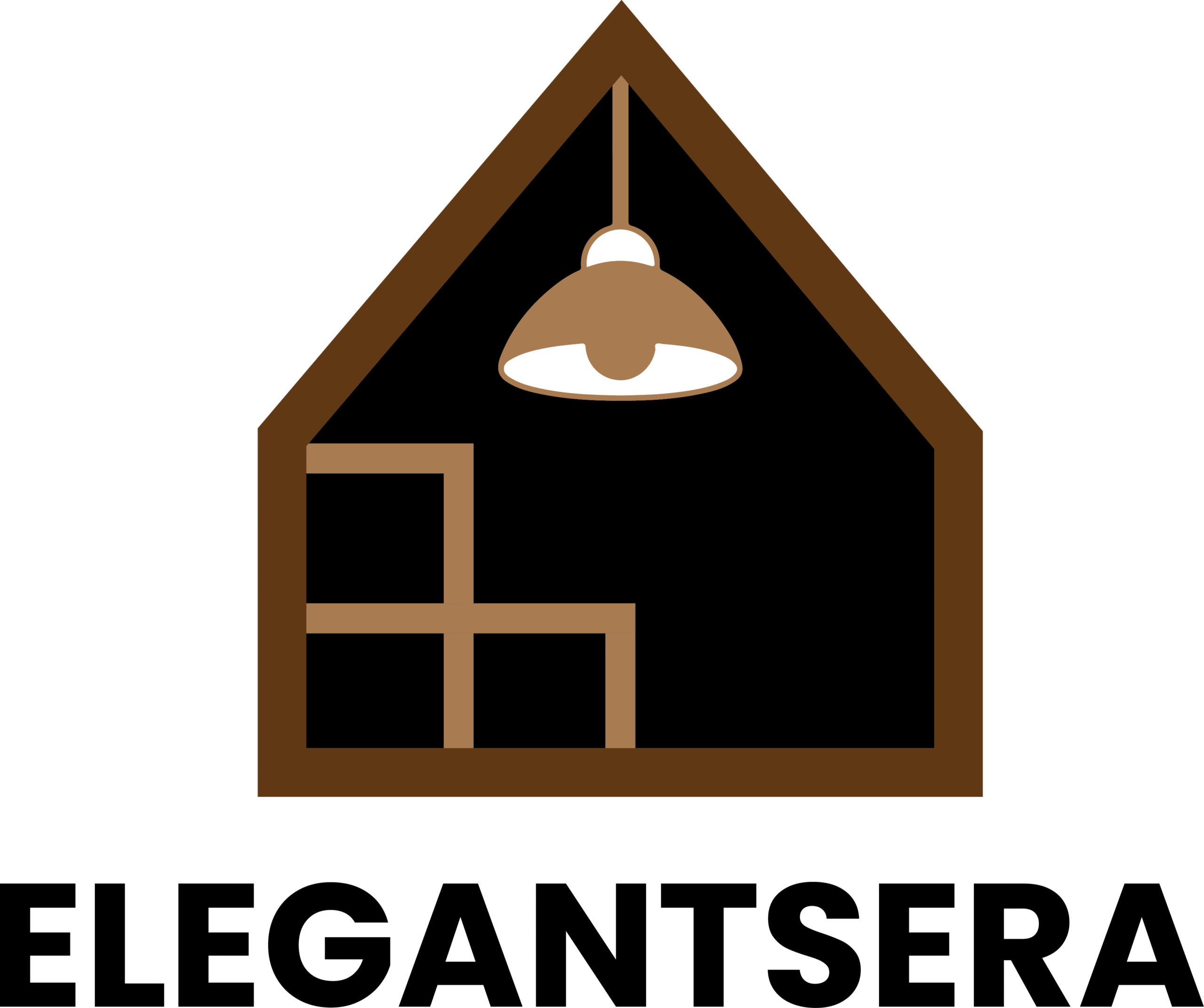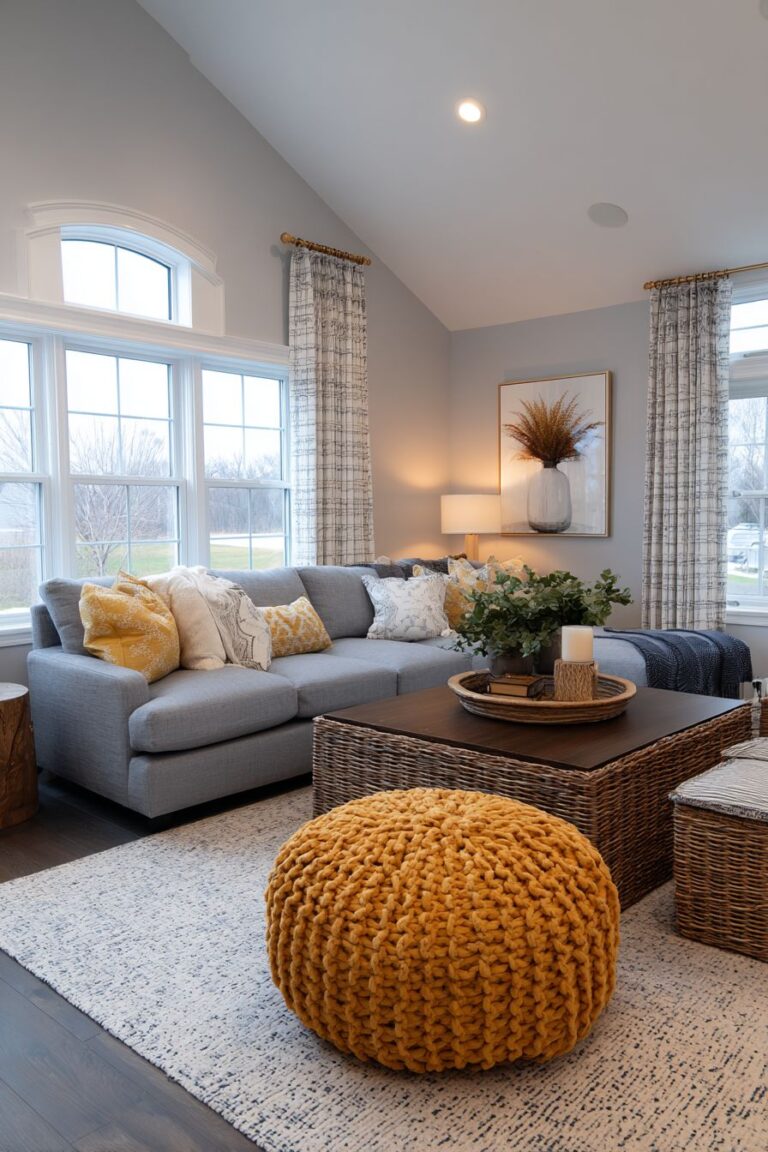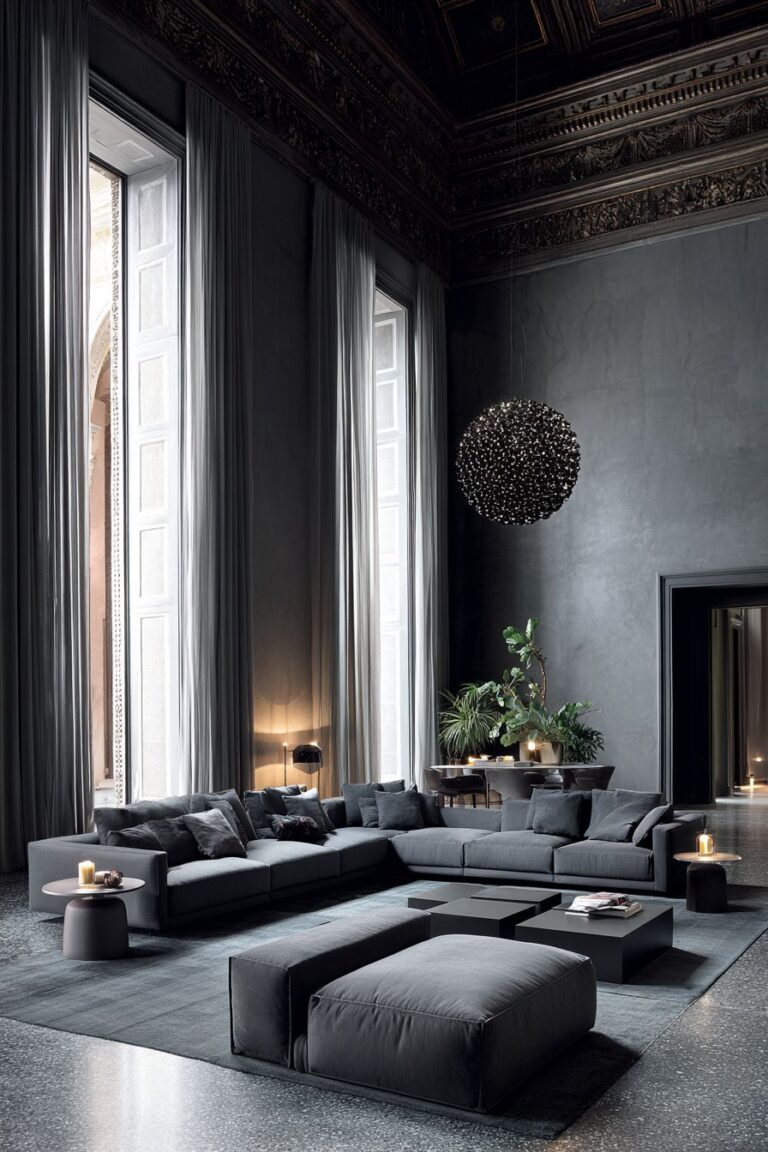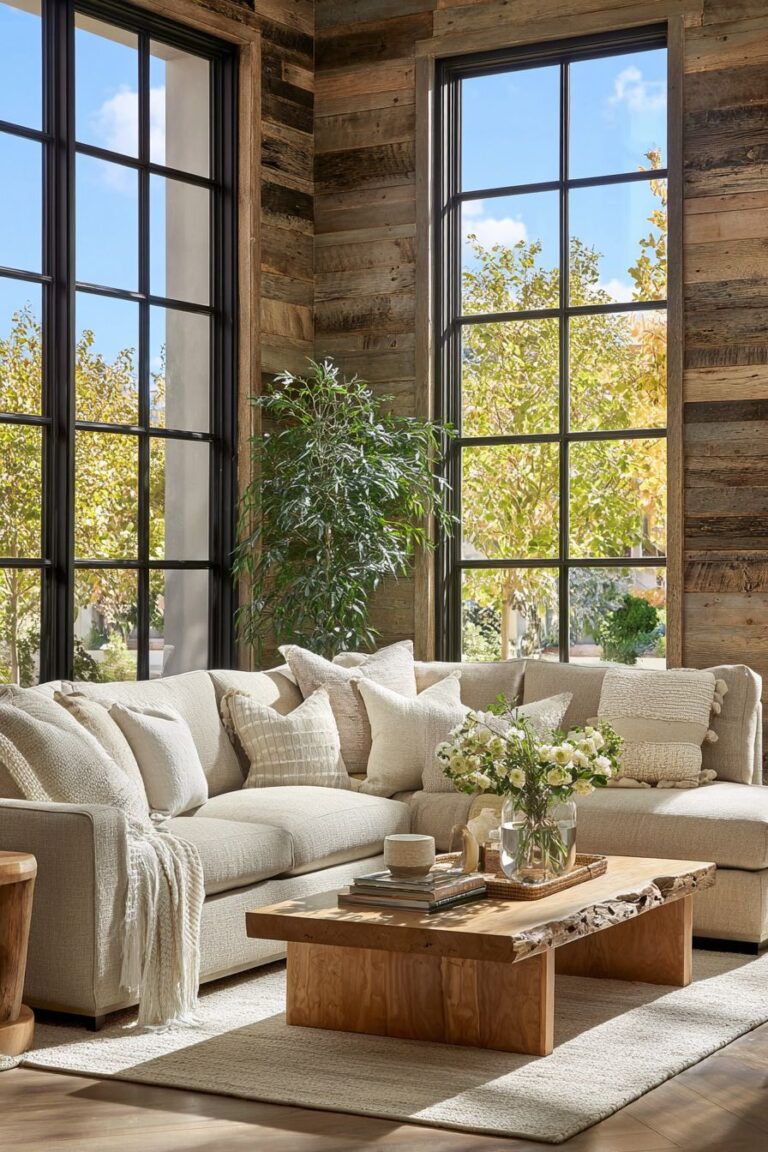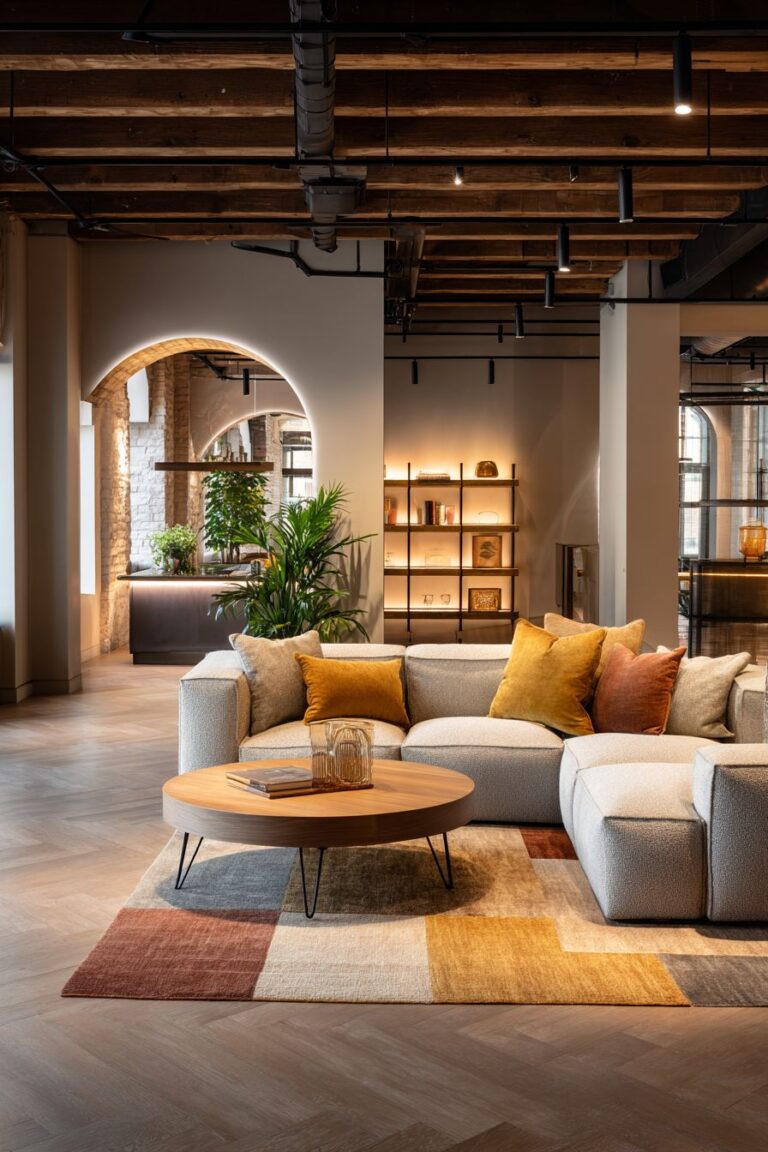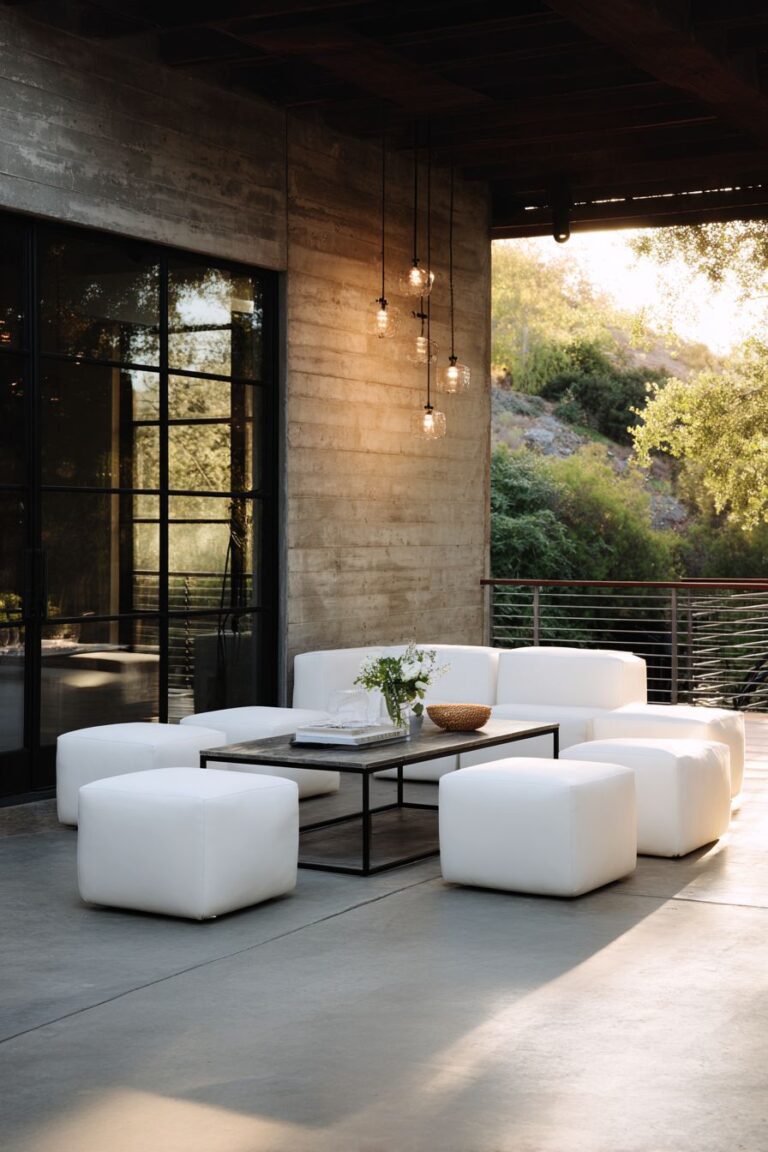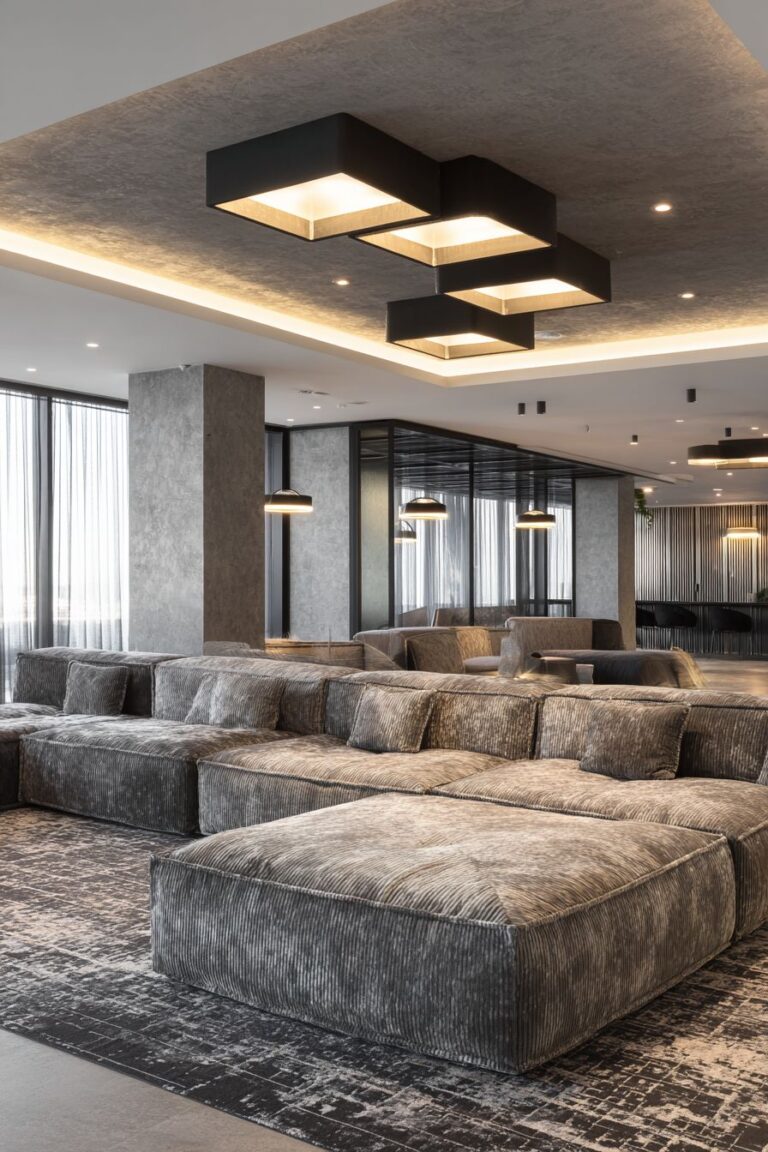19+ Floor Lamps Living Room: Ultimate Style Guide
Floor lamps are among the most versatile and impactful lighting solutions in interior design, serving as both functional illumination sources and striking decorative elements. In the living room, where we gather with family and friends, these towering fixtures do more than simply brighten dark corners—they create ambiance, define spaces, and express personal style. The right floor lamp can transform an ordinary living room into an extraordinary sanctuary, whether you’re seeking focused reading light, ambient evening glow, or a dramatic architectural statement piece.
The world of floor lamp design offers endless possibilities, from sleek contemporary arc lamps that curve gracefully over modern sectionals to rustic farmhouse fixtures crafted from reclaimed materials. Each style speaks to different personalities and lifestyles, whether you gravitate toward the clean lines of Scandinavian minimalism, the raw authenticity of industrial design, or the opulent glamour of Art Deco-inspired pieces. Understanding how different floor lamp styles integrate with various interior design themes allows homeowners to make informed choices that enhance both the functionality and aesthetic appeal of their living spaces.
In this comprehensive guide, we’ll explore twenty distinct floor lamp design concepts for living rooms, each representing a unique approach to combining form and function. From space-saving solutions perfect for small apartments to luxury designer pieces that serve as room focal points, these ideas demonstrate how thoughtful lighting design can elevate any living space. Whether you’re completely redesigning your living room or simply looking to refresh your current decor, these inspiring examples will help you discover the perfect floor lamp solution for your home.
1. Modern Arc Lamp Excellence with Contemporary Elegance

The sleek modern arc floor lamp represents the pinnacle of contemporary lighting design, featuring a brushed steel finish that catches and reflects light beautifully throughout the day. Positioned beside a sophisticated grey sectional sofa, this striking fixture demonstrates how functional lighting can serve as sculptural art. The lamp’s adjustable arm gracefully extends over the seating area, providing focused reading light exactly where needed while maintaining the clean aesthetic lines that define modern interior design.

Natural oak flooring with subtle grain patterns creates the perfect foundation for this minimalist approach, complementing the metallic finish of the lamp while adding warmth to the contemporary palette. The organic wood tones prevent the space from feeling cold or sterile, instead creating a balanced environment where natural materials harmonize with manufactured elements. Large windows dressed with white sheer curtains maximize natural light penetration, creating soft diffused daylight that works in harmony with the arc lamp’s targeted illumination.

The beauty of this design lies in its functional elegance—every element serves a purpose while contributing to the overall aesthetic impact. The arc lamp’s sculptural form becomes a focal point that draws the eye upward, creating visual interest and emphasizing the room’s vertical space. The brushed steel finish adds sophistication without overwhelming the neutral color scheme, while the adjustable positioning ensures practical lighting for various activities throughout the day.

Key Design Tips:
- Choose arc lamps with adjustable arms for maximum versatility in lighting placement
- Position the lamp to extend light over seating areas without creating glare on television screens
- Select metallic finishes that complement other hardware throughout the living space
- Ensure adequate clearance around the lamp’s arc to prevent accidental contact
- Consider the lamp’s scale relative to your furniture to maintain visual balance
2. Scandinavian Minimalism with Natural Warmth

Scandinavian design philosophy emphasizes simplicity, functionality, and connection to nature, perfectly embodied in a tripod floor lamp featuring white fabric shade and natural ash wood legs. This design approach creates living spaces that feel both sophisticated and approachable, where clean lines meet organic materials in harmonious balance. The lamp stands gracefully beside a cozy reading chair upholstered in light grey linen, creating an inviting corner perfect for quiet moments with a good book.
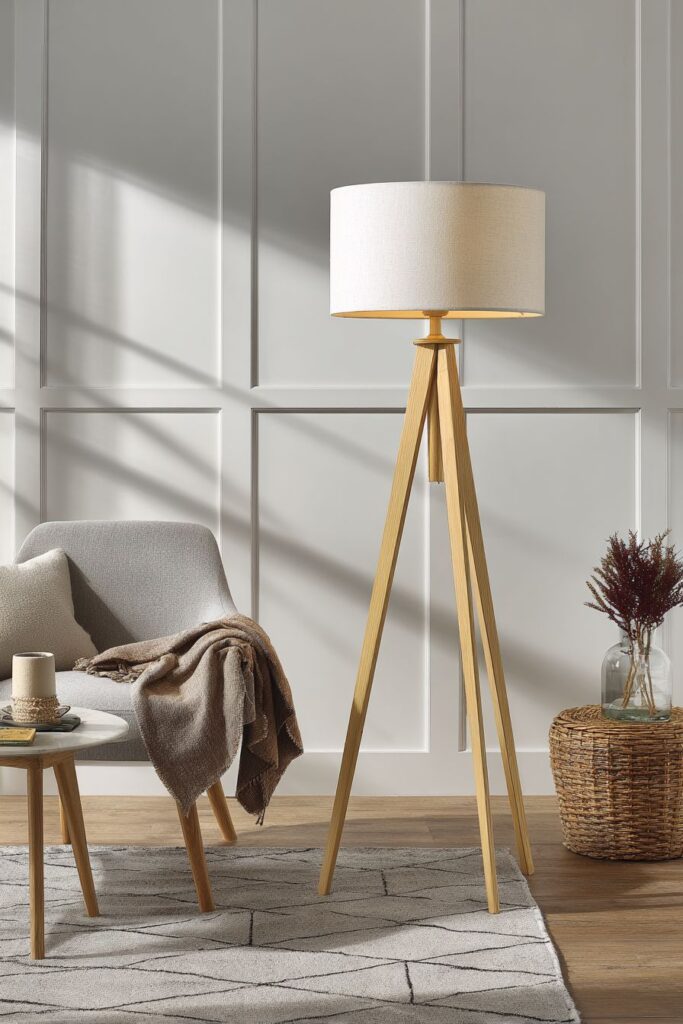
The geometric wool rug in muted tones serves as an anchor for the seating area, its subtle patterns adding visual interest without overwhelming the minimalist aesthetic. This careful layering of textures—smooth ash wood, soft linen upholstery, and woven wool fibers—creates depth and warmth in a palette dominated by whites and grays. The interplay of these natural materials prevents the space from feeling stark or cold, instead fostering a sense of hygge that makes the living room truly welcoming.

White walls create a clean backdrop that allows the natural wood tones and textile textures to shine, while maximizing the reflection of both natural and artificial light throughout the space. The tripod base of the floor lamp adds architectural interest with its angular geometry, contrasting beautifully with the soft curves of the fabric shade. The diffused illumination from the white shade creates a warm ambient glow that enhances the cozy atmosphere while providing sufficient light for reading and relaxation.
Professional photography of Scandinavian interiors often emphasizes the interplay between natural and artificial light sources, capturing how the soft glow from the lamp’s fabric shade complements daylight filtering through windows. This lighting technique creates an inviting atmosphere that changes throughout the day, from bright and energizing morning light to warm and cozy evening ambiance.
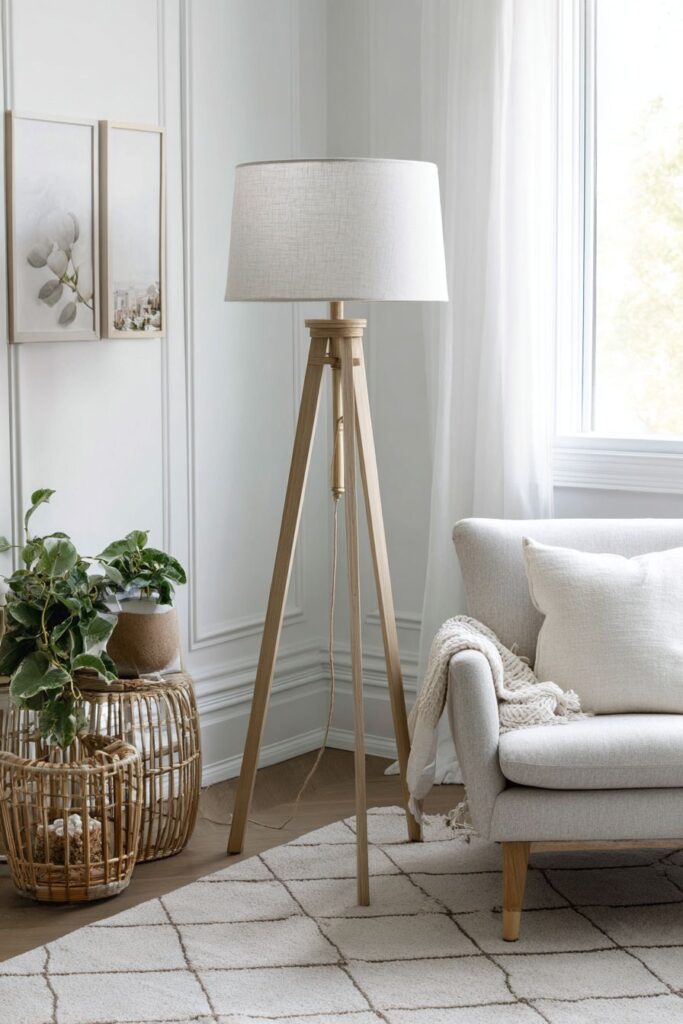
Key Design Tips:
- Select lamp bases made from light woods like ash, birch, or pine for authentic Scandinavian appeal
- Choose fabric shades in white or off-white to maximize light diffusion and maintain the airy aesthetic
- Position reading lamps at appropriate height for comfortable task lighting without glare
- Incorporate multiple texture layers through rugs, pillows, and upholstery to add warmth
- Maintain a neutral color palette with occasional pops of muted color through accessories
3. Industrial Strength with Urban Character

Industrial design brings raw urban authenticity to living spaces through the use of materials like black metal, exposed brick, and weathered concrete. An Edison bulb floor lamp with black metal framework and exposed copper wiring details perfectly embodies this aesthetic, creating a fixture that celebrates the beauty of utilitarian design. Standing against a brick accent wall in a converted loft space, the lamp becomes both functional lighting and artistic statement, its industrial heritage clearly visible in every design detail.

Polished concrete floors reflect the warm glow of the Edison bulb, creating interesting patterns of light and shadow that change throughout the day. The industrial aesthetic embraces imperfection and authenticity, celebrating materials in their raw or lightly processed state rather than concealing them behind decorative facades. Dark leather furniture and vintage wooden accents complete this masculine design approach, creating a living space that feels both sophisticated and approachable.

The exposed copper wiring adds an unexpected element of warmth to the otherwise cool metal framework, demonstrating how industrial design can incorporate subtle color variations without abandoning its core principles. The Edison bulb itself becomes a design element, its visible filaments creating patterns of light that dance across surrounding surfaces. This type of lighting creates dramatic contrasts between bright focal points and darker background areas, essential to achieving authentic industrial ambiance.
Natural daylight streaming through tall windows provides necessary balance to the interior lighting scheme, preventing the space from feeling too dark or enclosed. The interplay between warm Edison bulb illumination and cool natural daylight creates dynamic lighting conditions that enhance the textural qualities of brick, concrete, and metal surfaces throughout the day.

Key Design Tips:
- Choose Edison bulbs with visible filaments to emphasize the industrial aesthetic
- Incorporate mixed metals but maintain consistency in finish treatments
- Balance dark materials with adequate natural and artificial light sources
- Select furniture pieces that show wear and patina for authentic industrial character
- Use exposed structural elements like brick walls or steel beams as design features
4. Traditional Elegance with Timeless Appeal

Traditional interior design celebrates classic proportions, rich materials, and sophisticated color palettes that have remained appealing across generations. A brass torchiere floor lamp with frosted glass shade providing ambient uplighting represents the epitome of traditional lighting design, creating sophisticated illumination that enhances architectural details while maintaining period authenticity. The polished brass finish develops a beautiful patina over time, adding character and depth to the fixture’s appearance.

The torchiere design directs light upward toward the ceiling, where it bounces back down to create soft, even illumination throughout the room. This uplighting technique is particularly effective in spaces with crown molding and decorative ceiling details, as it highlights these architectural features while providing comfortable ambient light for evening gatherings. The frosted glass shade diffuses the light beautifully, eliminating harsh glare while creating a warm, welcoming atmosphere.

Rich mahogany furniture establishes the foundation for this classic interior style, its deep reddish-brown tones complementing the warm brass finish of the lamp. An ornate Persian rug adds layers of color, pattern, and texture to the space, its intricate designs telling stories of craftsmanship and cultural heritage. These traditional elements work together to create a living room that feels established and sophisticated, where quality materials and careful attention to detail create lasting beauty.
Cream-colored walls provide a neutral backdrop that allows the rich furniture finishes and brass lamp to take center stage, while reflecting light to keep the space feeling bright and open. The interplay between warm artificial light and cooler natural daylight creates dynamic conditions that change throughout the day, highlighting different aspects of the traditional decor as lighting conditions shift.

Key Design Tips:
- Choose torchiere lamps for rooms with high ceilings to maximize uplighting effectiveness
- Select brass finishes that complement other metallic elements in the room
- Position uplighting fixtures away from low ceilings to avoid creating hot spots
- Incorporate rich wood tones and luxurious textiles for authentic traditional appeal
- Layer lighting sources to create depth and visual interest in traditional settings
5. Ultra-Modern Minimalism with High-Tech Features

Contemporary design continues to evolve with advances in LED technology, creating floor lamps that offer unprecedented control over lighting quality and energy efficiency. A minimalist LED floor lamp with slim black profile and adjustable brightness controls represents the cutting edge of modern lighting design, where form follows function in pursuit of perfect simplicity. The ultra-modern fixture complements clean-lined furniture in neutral tones, creating a cohesive aesthetic that celebrates the beauty of restraint.

The slim profile of contemporary LED floor lamps makes them ideal for spaces where visual clutter must be minimized, providing necessary illumination without dominating the room’s aesthetic. Adjustable brightness controls allow users to customize lighting levels throughout the day, from energizing bright light for reading and work to soft ambient glow for relaxation and entertainment. This flexibility makes modern LED fixtures incredibly versatile, adapting to different activities and moods with simple adjustments.

Polished concrete floors reflect the lamp’s precise illumination, creating interesting patterns of light that emphasize the geometric qualities of contemporary furniture pieces. A glass coffee table adds to the minimalist aesthetic while providing functionality, its transparent surface maintaining visual flow throughout the space. The interplay between the lamp’s geometric form and the organic patterns of light it creates demonstrates how modern technology can enhance rather than detract from sophisticated interior design.
Wide-angle interior photography of contemporary spaces often emphasizes the contrast between geometric furniture forms and the organic patterns created by carefully controlled lighting. This photographic approach captures the essence of modern design, where every element is carefully considered for both functional performance and visual impact.

Key Design Tips:
- Select LED fixtures with dimming capabilities for maximum lighting flexibility
- Choose lamps with clean geometric forms that complement contemporary furniture
- Consider programmable lighting controls for automated daily lighting schedules
- Position modern fixtures to highlight architectural features and furniture silhouettes
- Maintain consistent finish treatments across all metallic elements in the room
6. Rustic Farmhouse Charm with Authentic Materials
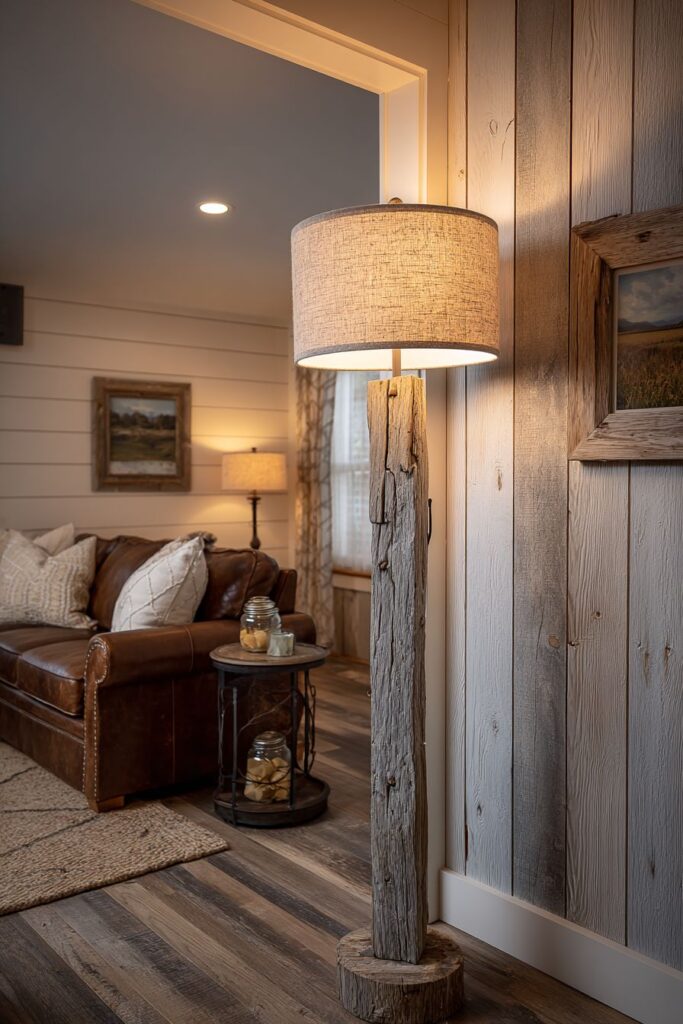
Farmhouse design celebrates the beauty of rural life through the use of reclaimed materials, natural textures, and handcrafted details that tell stories of heritage and tradition. A rustic floor lamp with reclaimed wood base and burlap drum shade embodies this authentic approach to interior design, creating a lighting fixture that appears to have been crafted by hand using materials sourced from local farms and workshops. Positioned near a distressed leather sofa, the lamp contributes to the lived-in atmosphere that makes farmhouse interiors so appealing.

Shiplap accent walls create horizontal lines that visually expand the space while adding textural interest through their subtle shadow patterns. This traditional wall treatment, originally used in agricultural buildings for its durability and weather resistance, has become a signature element of modern farmhouse design. Wide-plank hardwood floors complement the reclaimed wood lamp base, their natural variations in grain and color creating a foundation that celebrates the imperfect beauty of natural materials.
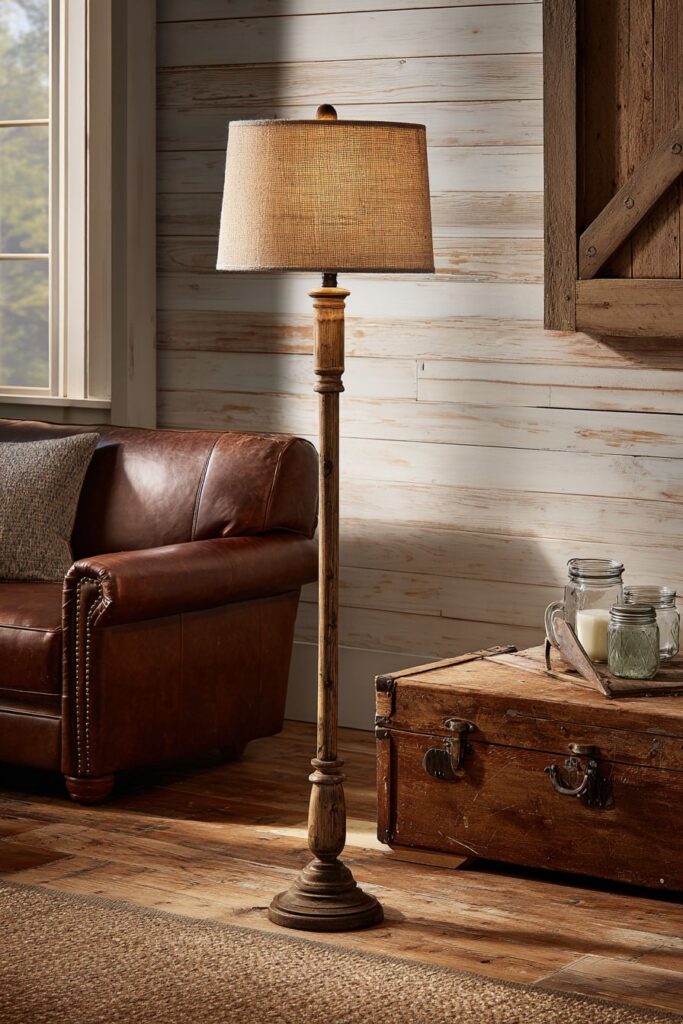
A vintage trunk serving as a coffee table adds functional storage while reinforcing the farmhouse aesthetic through its weathered finish and traditional construction details. Mason jar accents throughout the space reference agricultural heritage while providing opportunities to incorporate fresh flowers, herbs, or seasonal decorations that connect the interior to the natural world outside. These authentic details work together to create a living space that feels genuine rather than decorated.
The burlap drum shade filters light beautifully, creating a warm glow that enhances the cozy atmosphere essential to successful farmhouse design. Natural materials like burlap and reclaimed wood develop character over time, their surfaces telling stories of use and wear that add depth and authenticity to interior spaces. This patina of age cannot be replicated through artificial aging techniques, making genuine vintage and reclaimed materials particularly valuable in farmhouse interiors.
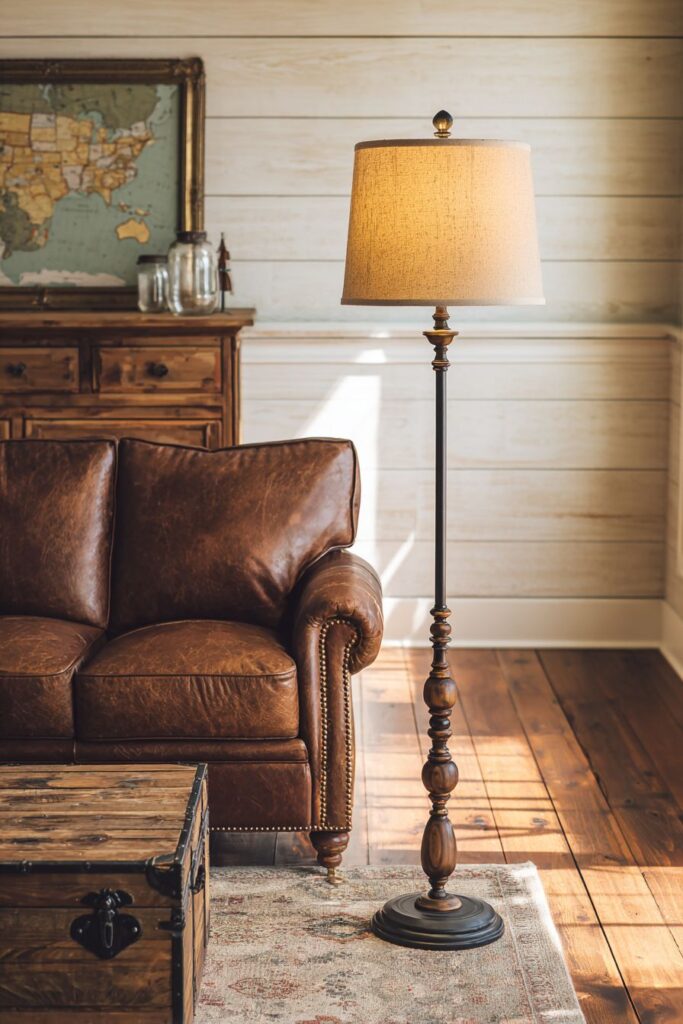
Key Design Tips:
- Source authentic reclaimed materials whenever possible for genuine farmhouse character
- Layer different natural textures through wood, burlap, leather, and woven fabrics
- Incorporate functional vintage pieces that serve practical purposes beyond decoration
- Choose warm lighting that enhances the cozy atmosphere of farmhouse interiors
- Display collections of mason jars, vintage tools, or agricultural artifacts as decorative elements
7. Mid-Century Modern Icon with Retro Sophistication

Mid-century modern design represents one of the most influential periods in furniture and lighting history, creating timeless pieces that remain as relevant today as when they were first introduced in the 1950s and 1960s. An iconic arc floor lamp with walnut wood base and white mushroom-shaped shade arching over a low-profile sectional in burnt orange velvet perfectly captures the essence of this design movement. The lamp’s sculptural silhouette makes it a functional work of art, demonstrating how mid-century designers seamlessly integrated form and function.

The walnut wood base adds warmth and natural beauty to the design, its rich grain patterns complementing the sleek curves of the lamp’s metal components. Walnut was a preferred material among mid-century furniture makers for its workability, durability, and sophisticated appearance, making it an authentic choice for period-appropriate lighting designs. The white mushroom-shaped shade provides excellent light diffusion while maintaining the clean, organic forms that characterize the best mid-century modern designs.

Geometric patterns in throw pillows complement the retro aesthetic without overwhelming the space, their bold designs adding visual interest while maintaining the sophisticated color palette that defines mid-century interiors. The burnt orange velvet sectional serves as both seating and color anchor, its rich hue providing warmth against the neutral backdrop of terrazzo flooring and floor-to-ceiling windows. This combination of warm and cool elements creates the balanced aesthetic that makes mid-century modern rooms so appealing.
Terrazzo flooring with its embedded stone chips adds textural interest while maintaining the smooth, continuous surfaces preferred in mid-century architecture. Floor-to-ceiling windows maximize natural light penetration while emphasizing the connection to outdoor spaces that was central to mid-century design philosophy. The interplay between artificial and natural light creates dynamic conditions that highlight the sculptural qualities of mid-century furniture and lighting throughout the day.

Key Design Tips:
- Choose authentic materials like walnut wood and brushed metals for period accuracy
- Select furniture with clean lines and organic curves characteristic of the era
- Incorporate bold accent colors while maintaining a sophisticated overall palette
- Position lighting to highlight the sculptural qualities of mid-century furniture
- Emphasize horizontal lines and open floor plans that connect indoor and outdoor spaces
8. Space-Saving Solutions for Small Living Areas
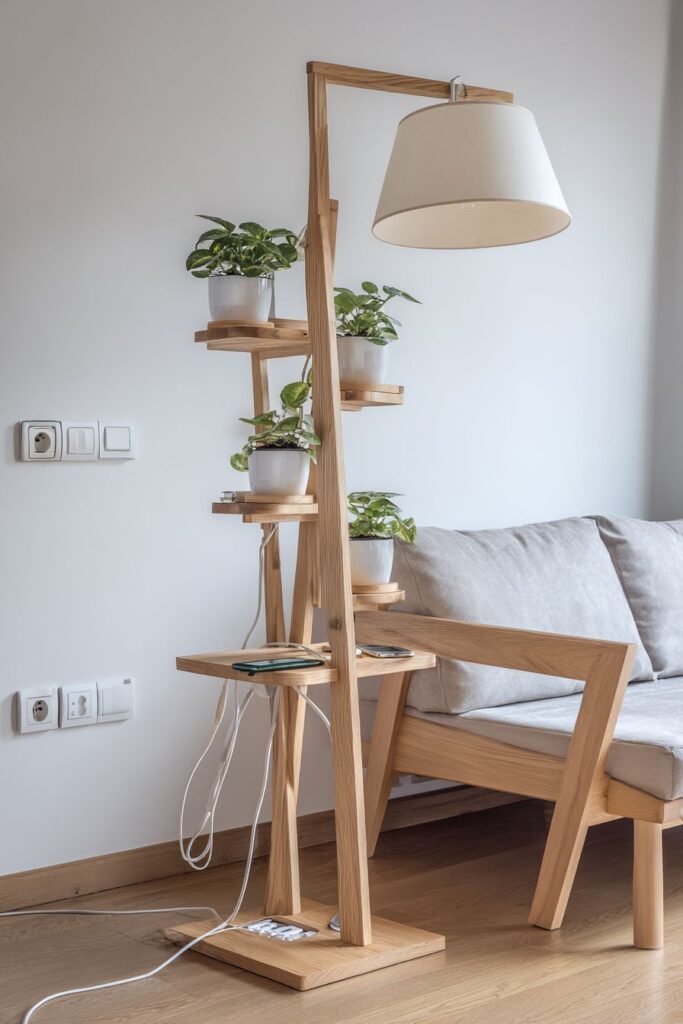
Small apartment living requires creative solutions that maximize functionality within limited square footage, making multi-purpose furniture and lighting essential for successful interior design. A space-saving corner floor lamp with built-in shelving and USB charging ports integrated into the base represents innovative thinking about how lighting fixtures can serve multiple functions simultaneously. This multi-functional approach makes every element work harder, crucial for creating comfortable and practical small living spaces.

The integrated shelving provides display space for books, plants, or decorative objects without requiring additional floor area, while USB charging ports eliminate the need for separate charging stations that can create visual clutter. These practical features demonstrate how modern lighting design continues to evolve in response to contemporary lifestyle needs, particularly in urban environments where space comes at a premium. The vertical design maximizes the use of often-underutilized corner spaces while providing both task and ambient lighting.
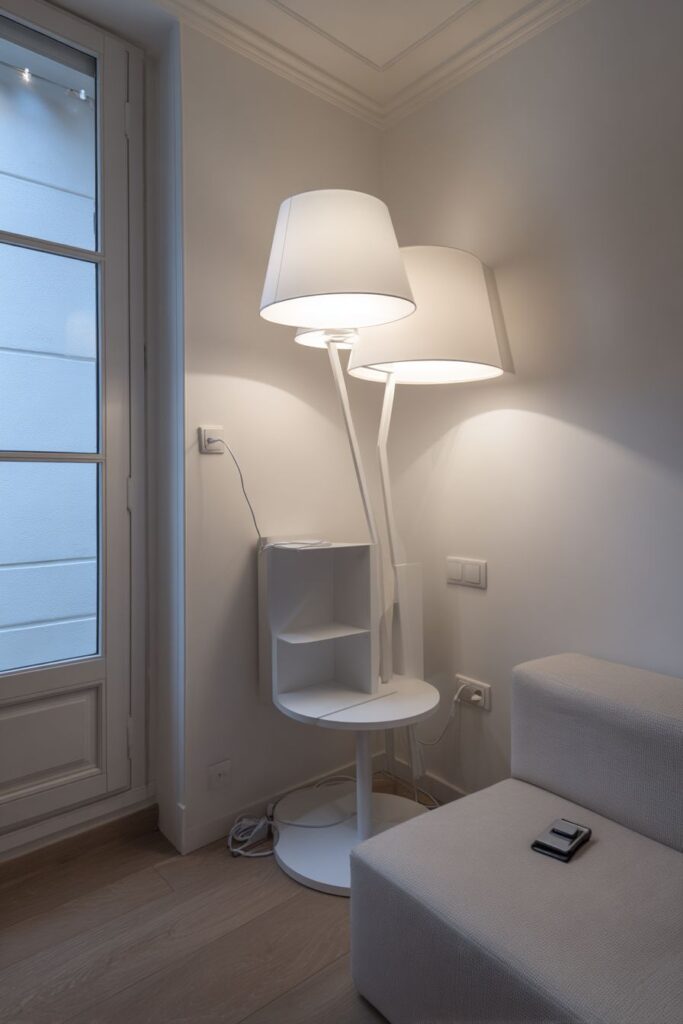
Light wood furniture and white walls create an airy feel that makes the compact space appear larger than its actual dimensions, a critical consideration in small apartment design. The pale color palette reflects available light throughout the space, preventing the room from feeling cramped or dark despite its limited size. A compact loveseat provides comfortable seating without overwhelming the space, its scaled proportions appropriate for the room’s dimensions.
Strategic positioning of the multi-functional lamp beside the loveseat creates a defined reading and relaxation area, demonstrating how careful furniture placement can create distinct zones within small spaces. The soft ambient lighting enhances the cozy atmosphere while ensuring adequate illumination for various activities throughout the day. This thoughtful approach to lighting design shows how small spaces can be both functional and beautiful when every element is carefully considered.
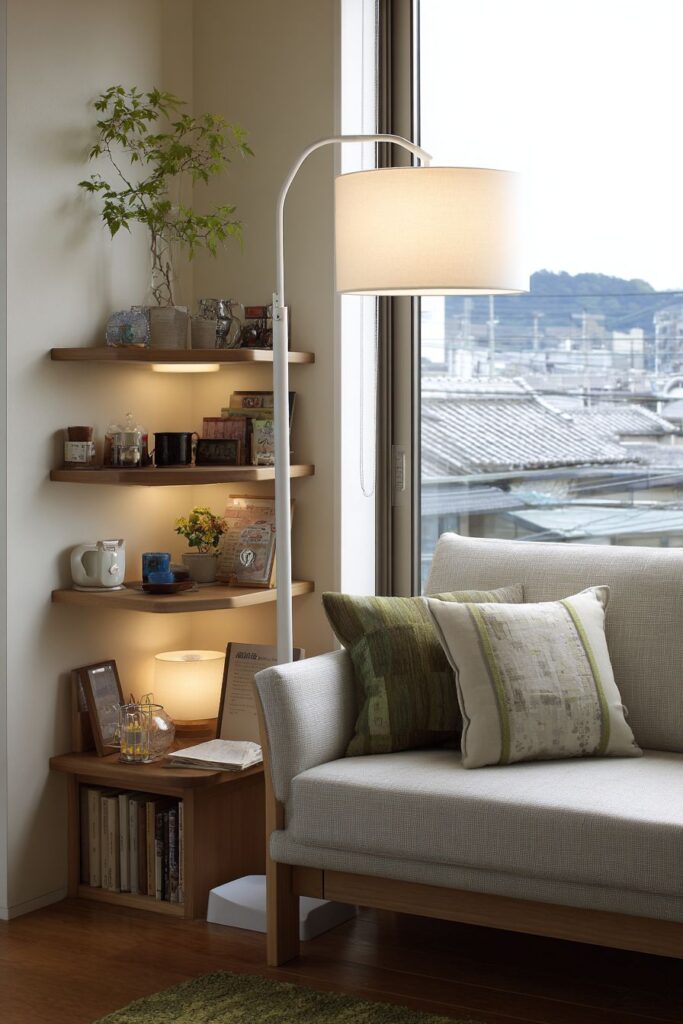
Key Design Tips:
- Select multi-functional furniture pieces that serve several purposes simultaneously
- Choose light colors and reflective surfaces to maximize the sense of space
- Position lighting to create defined zones within open floor plans
- Incorporate built-in storage solutions to minimize visual clutter
- Scale furniture appropriately to room dimensions to maintain comfortable circulation paths
9. Classic Traditional Sophistication with Literary Ambiance
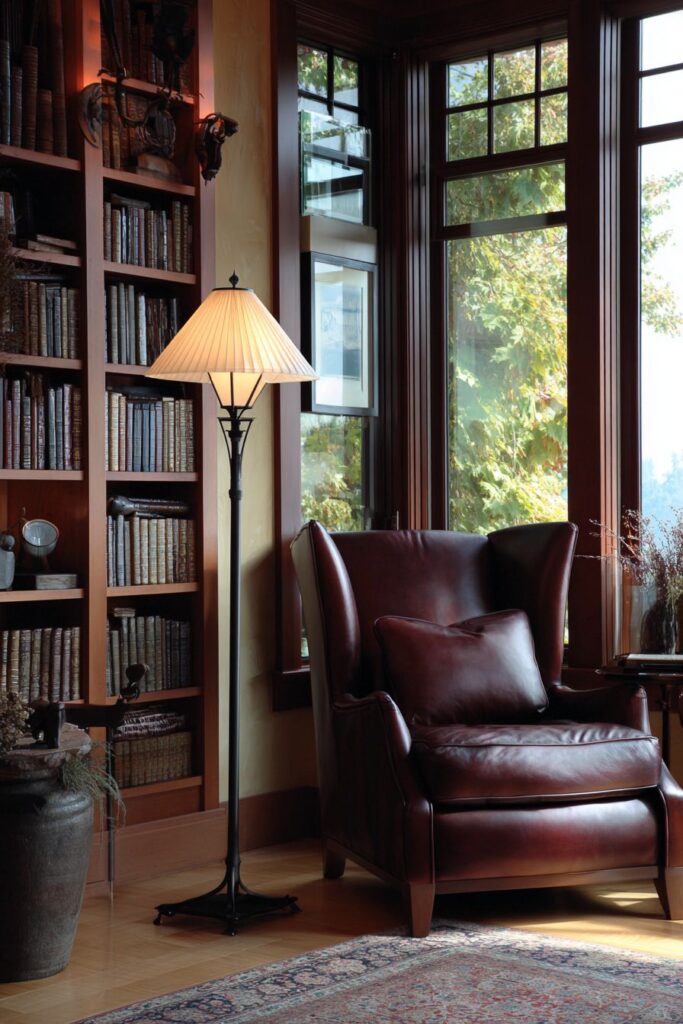
Traditional interior design at its finest creates spaces that feel both sophisticated and comfortable, where quality materials and careful attention to detail result in timeless beauty that transcends passing trends. A classic torchiere floor lamp with antiqued bronze finish and pleated fabric shade positioned beside a wingback chair in rich burgundy leather establishes an atmosphere reminiscent of a gentleman’s library or private study. The antiqued bronze finish adds depth and character to the fixture, suggesting years of careful maintenance and use.
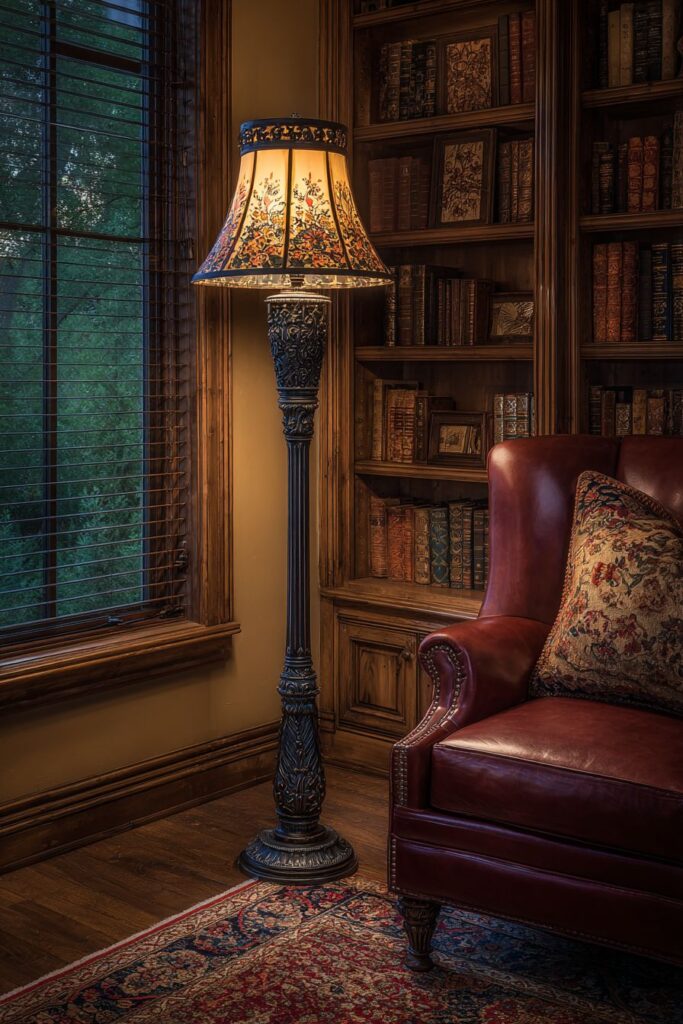
The pleated fabric shade creates interesting shadow patterns while diffusing light evenly throughout the space, providing comfortable illumination for reading while adding textural interest to the lamp’s silhouette. Persian rugs layered over hardwood floors demonstrate the traditional approach to creating warmth and visual interest through multiple pattern layers, their intricate designs adding cultural sophistication to the overall aesthetic. Built-in bookshelves filled with leather-bound volumes complete the literary atmosphere, creating a living space that celebrates learning and contemplation.
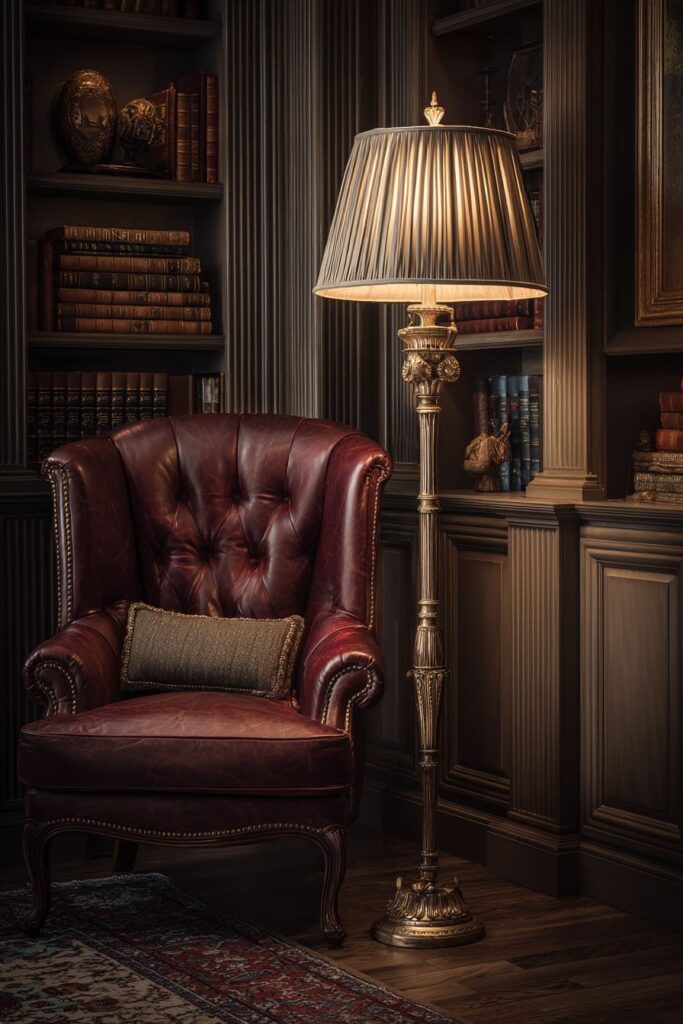
The rich burgundy leather wingback chair serves as both comfortable seating and statement piece, its traditional form and luxurious material establishing the room’s sophisticated character. Leather develops beautiful patina over time, becoming more attractive with age and use—a quality that aligns perfectly with traditional design values. The high back and winged sides of the chair create a sense of enclosure that makes reading more comfortable while adding architectural interest to the furniture arrangement.
Natural window light balances the warm artificial illumination, creating dynamic lighting conditions that change throughout the day. The interplay between uplighting from the torchiere and natural daylight prevents the space from feeling too enclosed or dark, essential for maintaining the welcoming atmosphere that makes traditional interiors so appealing. This layered lighting approach allows the space to function comfortably for various activities while maintaining its sophisticated ambiance.
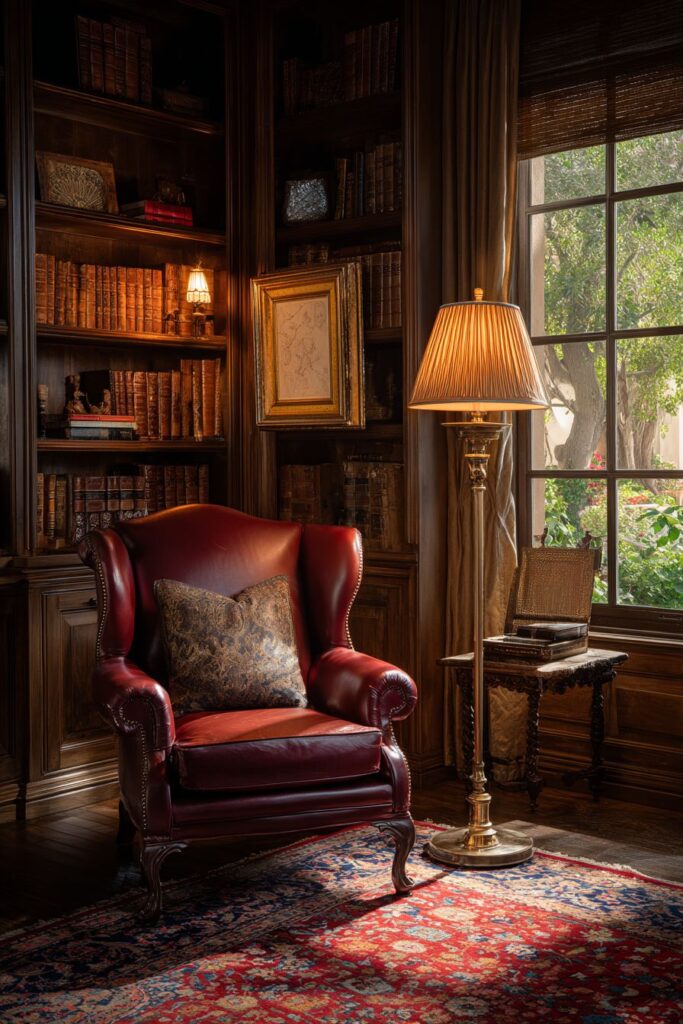
Key Design Tips:
- Layer multiple lighting sources to create depth and visual interest
- Choose quality materials that develop character and beauty over time
- Incorporate rich colors and luxurious textures for authentic traditional appeal
- Position reading lights at appropriate heights to prevent eye strain
- Display collections of books or artifacts that reflect personal interests and sophistication
10. Bohemian Eclectic Style with Global Inspiration

Bohemian interior design celebrates creativity, individuality, and cultural diversity through eclectic combinations of colors, patterns, and textures from around the world. A floor lamp with macramé shade and natural rattan base perfectly embodies this free-spirited approach, creating a lighting fixture that appears to have been collected during travels to exotic destinations. The handcrafted quality of macramé work adds artisanal appeal while demonstrating the bohemian appreciation for traditional crafts and techniques.

The natural rattan base connects the lamp to organic materials and sustainable design practices, its woven texture adding visual interest while maintaining the earthy palette that characterizes successful bohemian interiors. Surrounded by an eclectic mix of colorful textiles and plants, the lamp becomes part of a larger composition that celebrates abundance and creativity over minimalism and restraint. This maximalist approach requires careful curation to avoid chaos, balancing bold patterns and rich colors through repetition and thoughtful placement.

Moroccan poufs provide additional seating while contributing to the global aesthetic through their traditional construction and vibrant colors. Vintage tapestries and layered Persian rugs create a rich foundation of pattern and texture, their intricate designs telling stories of different cultures and craftspeople. Exposed brick walls and hardwood floors provide rustic texture that grounds the colorful accessories while adding architectural interest to the space.
Plants play a crucial role in bohemian interiors, connecting indoor spaces to the natural world while providing living color that changes with the seasons. The filtered light from the macramé shade enhances the room’s rich textures while creating interesting shadow patterns that dance across walls and surfaces throughout the day. This organic lighting quality perfectly complements the bohemian aesthetic, where imperfection and natural variation are celebrated rather than eliminated.

Key Design Tips:
- Layer multiple patterns and textures while maintaining color consistency for cohesion
- Incorporate handcrafted elements that show evidence of human skill and creativity
- Mix furniture and accessories from different cultures and time periods
- Use plants and natural materials to connect indoor spaces to the natural world
- Allow for imperfection and organic variation rather than rigid symmetry
11. Coordinated Lighting Design with Professional Results

Successful lighting design requires understanding how different light sources work together to create both functional illumination and aesthetic appeal throughout a living space. Multiple coordinated floor lamps, including a reading lamp beside an armchair and a taller ambient lamp near the entertainment center, demonstrate professional lighting principles in action. The matching brushed nickel fixtures with white linen shades create visual cohesion while serving different functional purposes within the same space.

Layered lighting approaches use three types of illumination: ambient lighting for overall room brightness, task lighting for specific activities like reading, and accent lighting to highlight architectural features or artwork. This comprehensive strategy ensures comfortable lighting conditions for various activities while creating visual depth and interest throughout the day and evening hours. The white linen shades provide excellent light diffusion while maintaining a neutral appearance that complements the contemporary color scheme.

A sectional sofa in charcoal grey anchors the seating area while providing a sophisticated backdrop for the coordinated lighting fixtures, its neutral tone allowing the brushed nickel finishes to stand out without creating visual conflict. The glass coffee table reflects the varied light sources throughout the space, creating interesting patterns and adding sparkle to the overall composition. This interplay between reflective and absorptive surfaces helps distribute light evenly while adding visual complexity to the room.
Professional lighting design considers both daytime and evening lighting needs, ensuring spaces remain functional and attractive regardless of natural light availability. The coordinated floor lamps provide flexibility for different occasions, from bright task lighting for reading and work to soft ambient glow for entertaining and relaxation. This versatility makes the living room truly multi-functional, adapting to various activities and moods throughout the day.

Key Design Tips:
- Select coordinating fixtures with consistent finish treatments for visual cohesion
- Layer different types of lighting to accommodate various activities and times of day
- Position task lighting appropriately for comfortable use without creating glare
- Consider how reflective surfaces distribute and enhance artificial light sources
- Plan lighting schemes that work effectively with available natural light
12. Task-Oriented Precision with Contemporary Functionality

Modern living often requires dedicated workspace areas within the main living areas, making adjustable task lighting essential for comfort and productivity. An adjustable floor lamp with articulating arm and focused LED spotlight positioned beside a modern desk area demonstrates how contemporary lighting design addresses specific functional needs while maintaining aesthetic appeal. The sleek black metal fixture offers precise directional lighting that can be positioned exactly where needed for various tasks.

LED technology provides several advantages for task lighting applications, including energy efficiency, long lifespan, and minimal heat generation that makes extended use comfortable. The focused spotlight design concentrates illumination exactly where needed, reducing eye strain while minimizing light spillage that could create glare on computer screens or interfere with other activities in the shared living space. This precision makes LED task lighting ideal for modern multi-functional living areas.

Contemporary furniture in white and grey tones maintains a cohesive aesthetic that allows the task lamp to integrate seamlessly with the overall design scheme. The neutral color palette provides a sophisticated backdrop that doesn’t compete with the precision engineering of the adjustable lighting fixture, allowing its functional beauty to shine. The clean lines and geometric forms of contemporary furniture complement the angular adjustments and sleek profile of modern task lighting.
The versatility of adjustable task lighting makes it valuable for various activities beyond traditional desk work, including detailed crafts, model building, or any precision task that requires focused illumination. The articulating arm allows users to position light at optimal angles while avoiding shadows and glare, essential for comfortable extended use. This functionality demonstrates how modern lighting design continues to evolve in response to changing lifestyle needs and technological capabilities.

Key Design Tips:
- Choose LED fixtures for task lighting to minimize heat and maximize efficiency
- Select adjustable designs that can be positioned precisely where light is needed
- Consider the color temperature of LED bulbs for optimal task performance
- Position task lighting to minimize shadows and glare on work surfaces
- Integrate task lighting fixtures with the overall design aesthetic of the living space
13. Industrial Artistry with Custom Craftsmanship

Industrial loft living celebrates the beauty of raw materials and utilitarian design through creative reinterpretation of commercial and manufacturing elements. A statement floor lamp made from repurposed pipe fittings and Edison bulbs creates dramatic sculptural lighting that serves as both functional illumination and artistic centerpiece. This approach to industrial design requires skilled craftsmanship to transform utilitarian components into sophisticated interior elements that maintain their authentic character.

Exposed ductwork, steel beams, and polished concrete floors establish the urban aesthetic that makes loft living so appealing to those who appreciate honest materials and unadorned structural elements. These architectural features provide the perfect backdrop for custom lighting fixtures that celebrate industrial heritage while meeting contemporary lighting needs. The raw materials develop patina over time, adding character and depth that cannot be achieved through artificial aging techniques.

Vintage leather furniture and metal accents complement the custom pipe fixture, creating a cohesive design scheme that feels authentic rather than contrived. The warm Edison bulb illumination softens the harder edges of industrial materials, creating a comfortable living environment that maintains its urban edge while providing necessary comfort and functionality. This balance between raw authenticity and livable comfort defines successful industrial interior design.
Professional photography of industrial interiors often emphasizes dramatic lighting contrasts, capturing how artificial light interacts with raw materials to create mood and atmosphere. The sculptural qualities of custom industrial lighting fixtures make them natural focal points, their utilitarian beauty serving as conversation pieces that reflect the owner’s appreciation for authentic design and skilled craftsmanship.

Key Design Tips:
- Source authentic industrial materials rather than manufactured replicas when possible
- Balance raw industrial elements with comfortable seating and soft textiles
- Incorporate custom lighting fixtures that celebrate utilitarian beauty
- Allow patina and wear patterns to develop naturally over time
- Maintain exposed structural elements as design features rather than hiding them
14. Coastal Serenity with Natural Materials
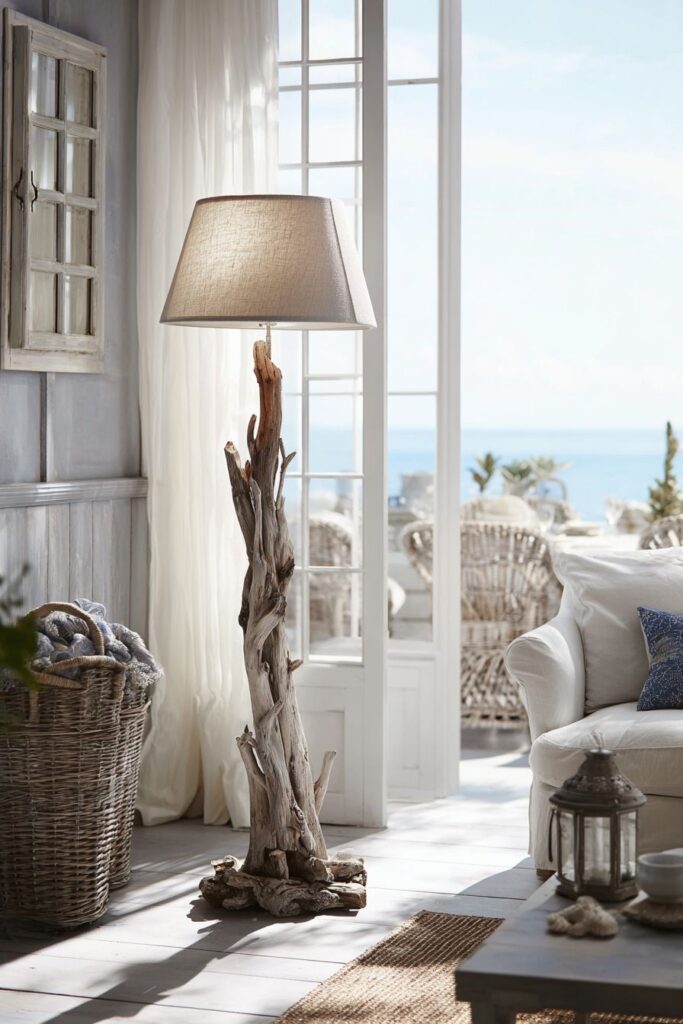
Coastal interior design captures the relaxed atmosphere of seaside living through the use of natural materials, weathered finishes, and color palettes inspired by ocean, sand, and sky. A floor lamp with driftwood base and natural linen shade positioned near French doors creates a perfect example of how coastal elements can be incorporated into sophisticated interior lighting. The organic shapes and weathered textures of driftwood add authentic coastal character while providing a unique base for functional lighting.
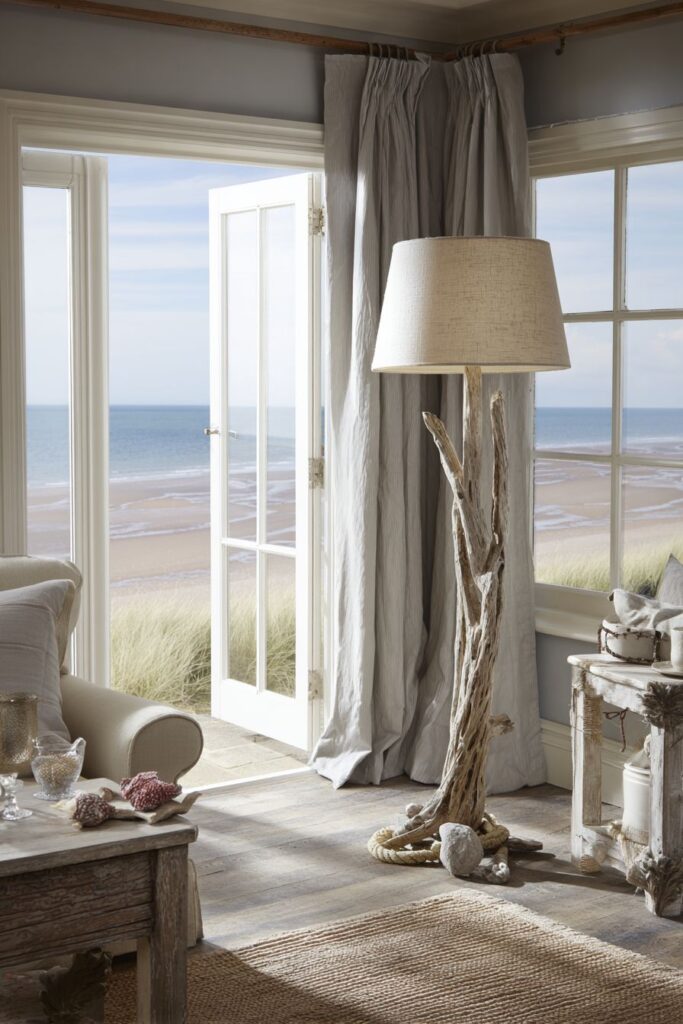
Weathered wood furniture in white and natural tones complements the driftwood lamp base while reinforcing the coastal aesthetic through consistent material choices and finish treatments. Rope and nautical accents throughout the space reference maritime heritage without overwhelming the sophisticated design, their functional beauty adding authentic touches that feel genuine rather than theatrical. These natural materials work together to create a cohesive design that celebrates coastal living.
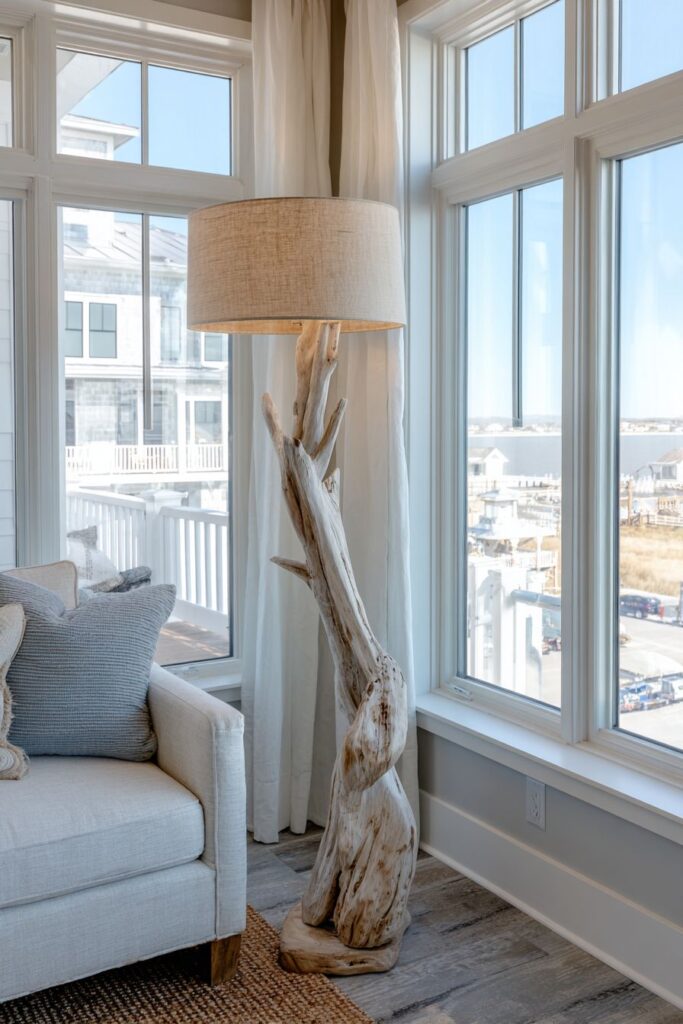
Sisal rugs and sea glass accessories complete the beachy aesthetic while providing practical benefits including durability and easy maintenance essential for coastal environments. The natural fiber rugs add textural interest while maintaining the neutral color palette that allows views of the seaside landscape to take center stage. Sea glass accessories catch and reflect light beautifully, adding sparkle and color variation that mimics the ever-changing qualities of ocean water.
French doors leading to seaside views integrate indoor and outdoor spaces, a fundamental principle of coastal design that emphasizes connection to the natural environment. The natural linen shade diffuses light beautifully while allowing the organic shapes of the driftwood base to create interesting shadow patterns throughout the day. This interplay between natural and artificial light sources creates the gentle, relaxed atmosphere that makes coastal interiors so appealing.
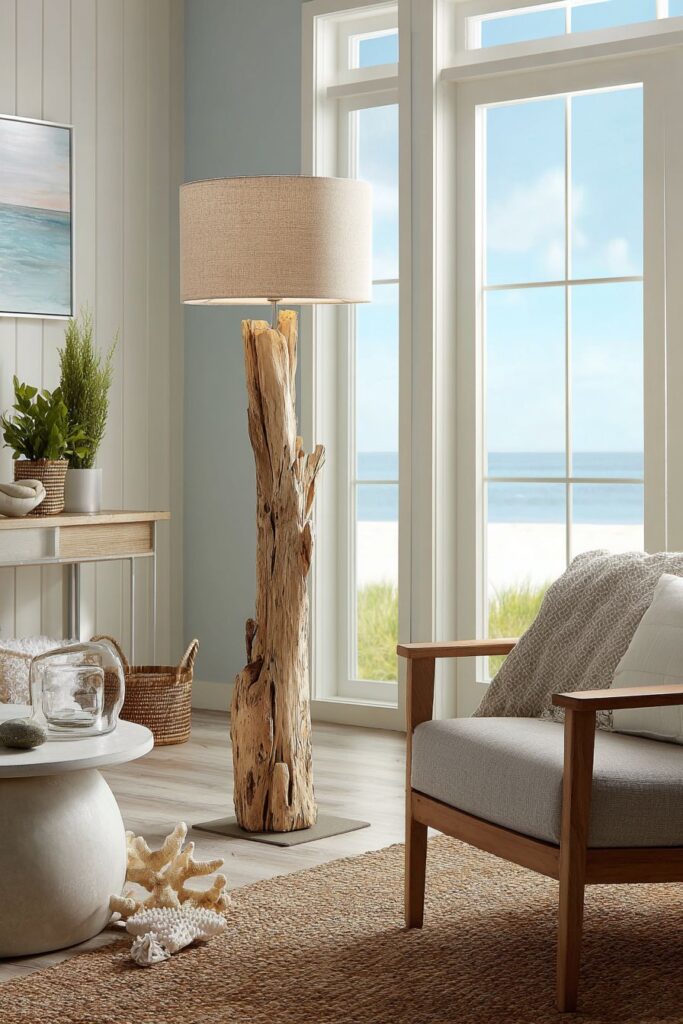
Key Design Tips:
- Incorporate authentic coastal materials like driftwood, rope, and weathered wood
- Choose natural fiber textiles and rugs for durability and appropriate texture
- Maintain neutral color palettes that complement natural coastal views
- Integrate indoor and outdoor spaces through strategic window and door placement
- Allow natural materials to show their authentic weathered character rather than refinishing them
15. Art Deco Glamour with Geometric Sophistication

Art Deco design represents the height of early 20th-century glamour, combining geometric forms with luxurious materials to create interiors that exude sophistication and drama. An Art Deco-inspired floor lamp with geometric brass base and frosted glass panels creates sophisticated ambient lighting while serving as a sculptural focal point that anchors the room’s design scheme. The angular fixture demonstrates the movement’s celebration of machine-age aesthetics combined with handcrafted luxury.

The geometric brass base showcases the precision and angular beauty that defines Art Deco design, its metallic surfaces reflecting light throughout the day to create ever-changing patterns of brightness and shadow. Frosted glass panels provide excellent light diffusion while maintaining the clean geometric forms essential to the Art Deco aesthetic, their smooth surfaces adding elegance while softening the harder edges of the metallic components. This combination of materials creates visual interest while maintaining period authenticity.

Velvet furniture in jewel tones and a black and gold color scheme establishes the rich, luxurious atmosphere that Art Deco interiors are famous for, the deep colors providing dramatic contrast against metallic surfaces and geometric patterns. Marble accents and mirrored surfaces reflect the lamp’s elegant design while multiplying light sources throughout the space, creating the glamorous atmosphere that defines successful Art Deco interiors. These reflective surfaces are essential for achieving the sparkling quality that makes Art Deco spaces so visually striking.
The period’s emphasis on geometric forms creates dramatic shadows and reflections that change throughout the day, making lighting a crucial element in Art Deco interior design. The interplay between natural daylight and artificial illumination highlights the geometric qualities of furniture and architectural details while creating the dramatic contrasts that make Art Deco spaces so photogenic and memorable.

Key Design Tips:
- Incorporate geometric patterns and angular forms throughout the design scheme
- Choose luxurious materials like brass, marble, and velvet for authentic period appeal
- Use mirrored and metallic surfaces to multiply light sources and create sparkle
- Select rich jewel tone colors for dramatic contrast with metallic elements
- Emphasize vertical lines and stepped geometric forms characteristic of the period
16. Mountain Lodge Comfort with Handcrafted Details
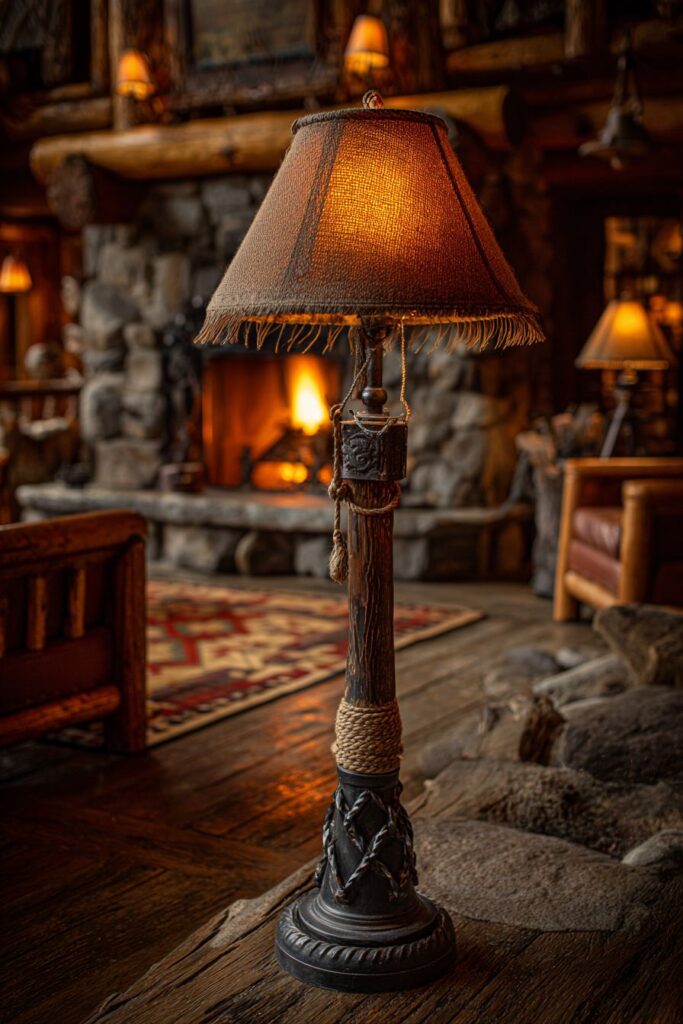
Mountain lodge design celebrates the beauty of natural materials and traditional craftsmanship through furniture and lighting that appears handmade from local materials. A rustic floor lamp combining reclaimed barn wood with wrought iron details positioned beside a stone fireplace creates the perfect example of how authentic materials can be combined to create functional art. The handcrafted fixture features a burlap shade and rope accents that complement the overall aesthetic while providing warm, diffused lighting.
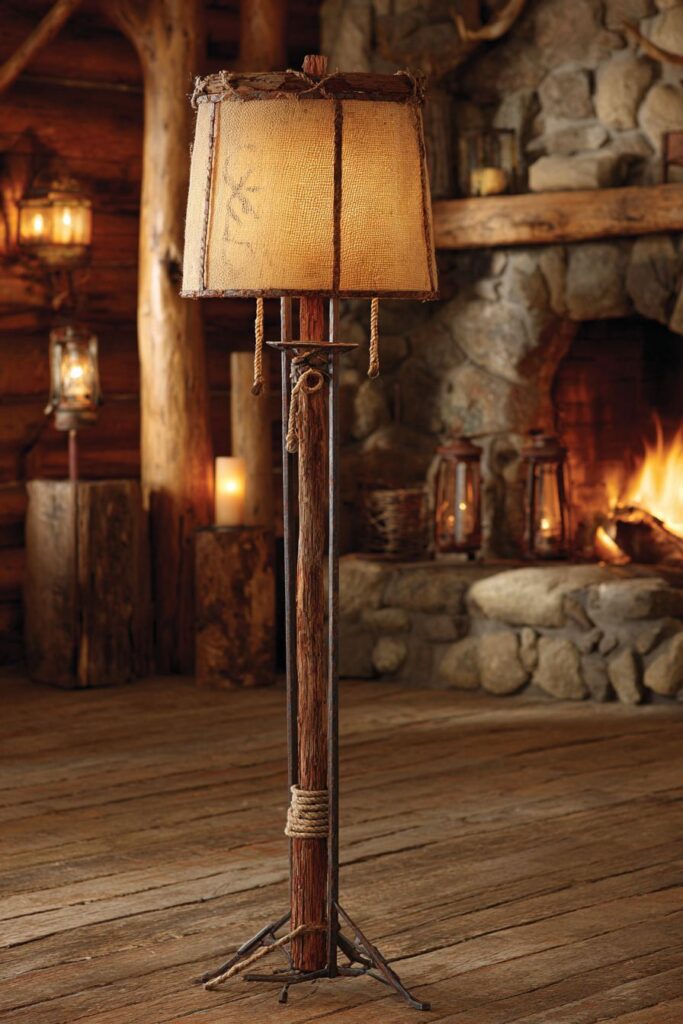
The combination of reclaimed barn wood and wrought iron demonstrates traditional building techniques while creating a lighting fixture with authentic character and substantial visual weight. Log cabin furniture and Native American textiles complete the mountain aesthetic through their connection to regional heritage and traditional craftsmanship techniques. These elements work together to create a living space that feels connected to its natural environment rather than imposed upon it.
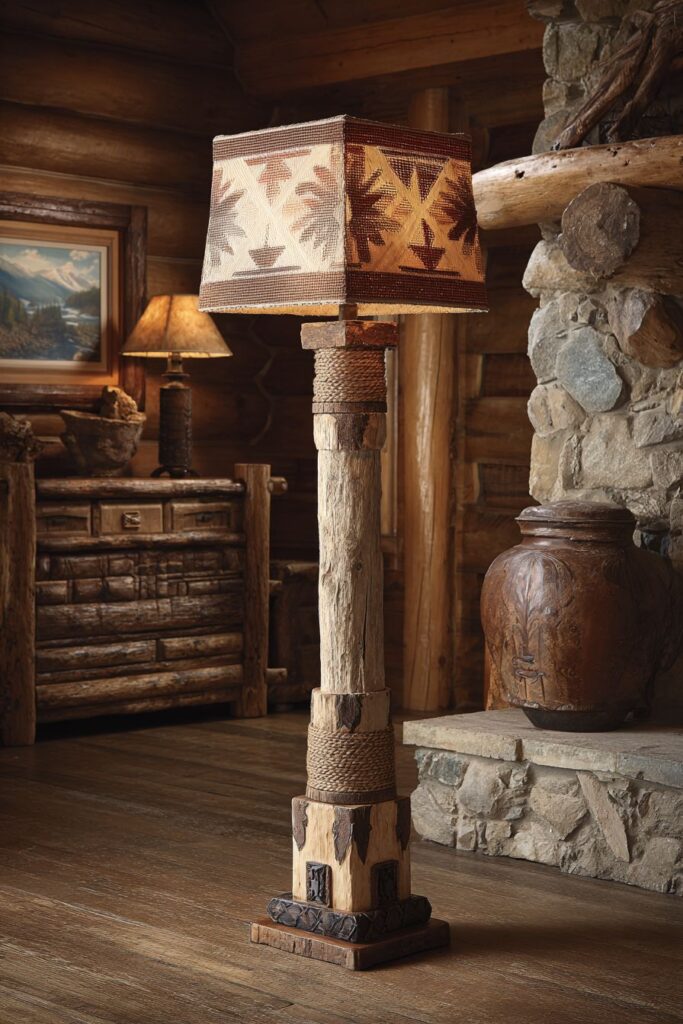
Wide-plank pine floors and exposed beam ceilings provide the architectural foundation that makes mountain lodge interiors so appealing, their substantial proportions and natural materials creating a sense of permanence and stability. The stone fireplace serves as both functional heating source and design anchor, its massive presence providing a focal point around which other elements can be arranged. This connection to traditional heating and lighting methods reinforces the authentic character of the space.
The warm illumination from both firelight and lamp creates a cozy atmosphere perfect for gathering and relaxation, the multiple light sources providing flexibility for different activities and times of day. The interplay between the flickering firelight and steady lamp illumination creates dynamic lighting conditions that enhance the textural qualities of natural materials throughout the space.
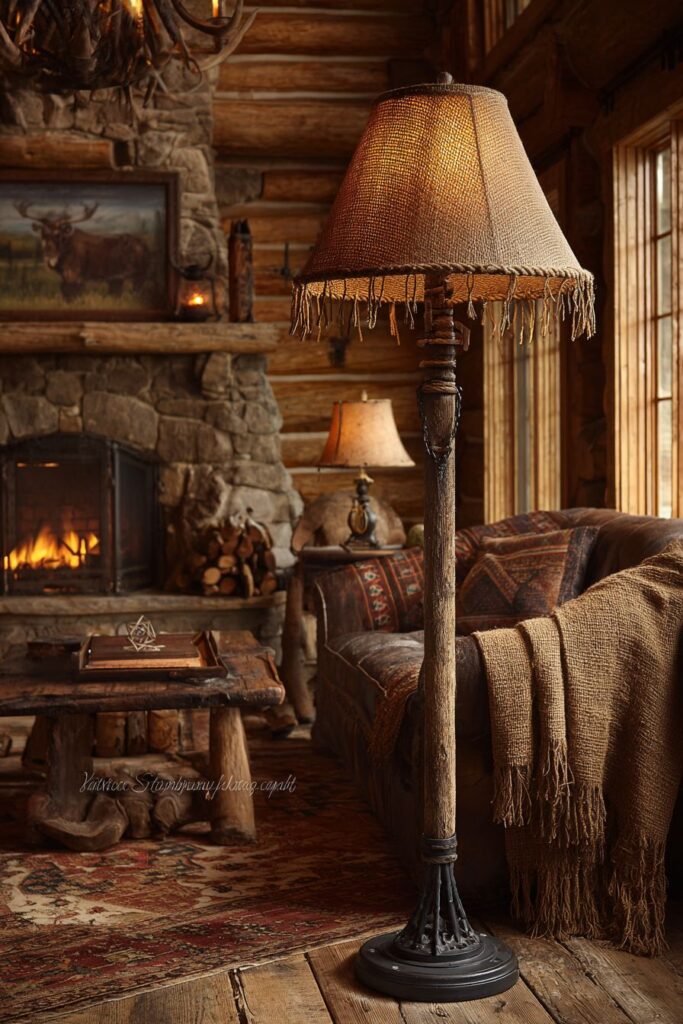
Key Design Tips:
- Source authentic reclaimed materials for genuine character and environmental sustainability
- Combine different natural materials like wood, iron, and stone for textural interest
- Incorporate regional textile traditions and craft techniques
- Maintain substantial proportions appropriate for rustic mountain settings
- Layer multiple light sources including firelight for authentic lodge ambiance
17. Luxury Designer Excellence with Precious Materials

High-end interior design represents the pinnacle of material quality, craftsmanship, and design sophistication, creating spaces where every element reflects careful attention to detail and uncompromising standards. A luxury designer floor lamp with crystal accents and silk shade positioned in an upscale setting demonstrates how premium materials and expert craftsmanship combine to create lighting fixtures that serve as functional jewelry. The crystal accents catch and refract light beautifully, creating sparkle and visual interest that changes throughout the day.

Custom millwork and high-end furnishings establish the sophisticated backdrop necessary for showcasing luxury lighting fixtures, their precise construction and premium materials providing context that allows expensive pieces to shine. A tufted velvet sofa in rich emerald green serves as both comfortable seating and color anchor, its luxurious fabric and expert tailoring demonstrating the level of quality that defines high-end interiors. The deep jewel tone provides dramatic contrast against neutral backgrounds while complementing metallic accents.

Marble floors with intricate inlay patterns and coffered ceilings establish the formal atmosphere essential for luxury interiors, their substantial construction and decorative details requiring skilled craftspeople and expensive materials. These architectural elements provide the foundation that supports and enhances expensive furnishings and lighting fixtures, creating spaces where quality is evident in every detail. The inlay patterns add visual interest while demonstrating the level of craftsmanship possible when budget constraints are removed.
Professional photography of luxury interiors requires careful attention to lighting balance, capturing the exquisite details and precious materials that justify premium pricing. The silk shade provides beautiful light diffusion while adding textural sophistication, its lustrous surface reflecting light in ways that synthetic materials cannot replicate. This attention to material quality and lighting effects creates the refined atmosphere that makes luxury interiors so appealing to those who appreciate the finest things.

Key Design Tips:
- Invest in quality materials like crystal, silk, and precious metals for authentic luxury appeal
- Ensure architectural details and millwork match the quality level of furnishings
- Balance dramatic colors with neutral backgrounds to prevent overwhelming the space
- Layer multiple lighting sources to highlight precious materials and expert craftsmanship
- Consider professional lighting design to maximize the impact of expensive fixtures
18. Vintage Eclectic Charm with Collected Character
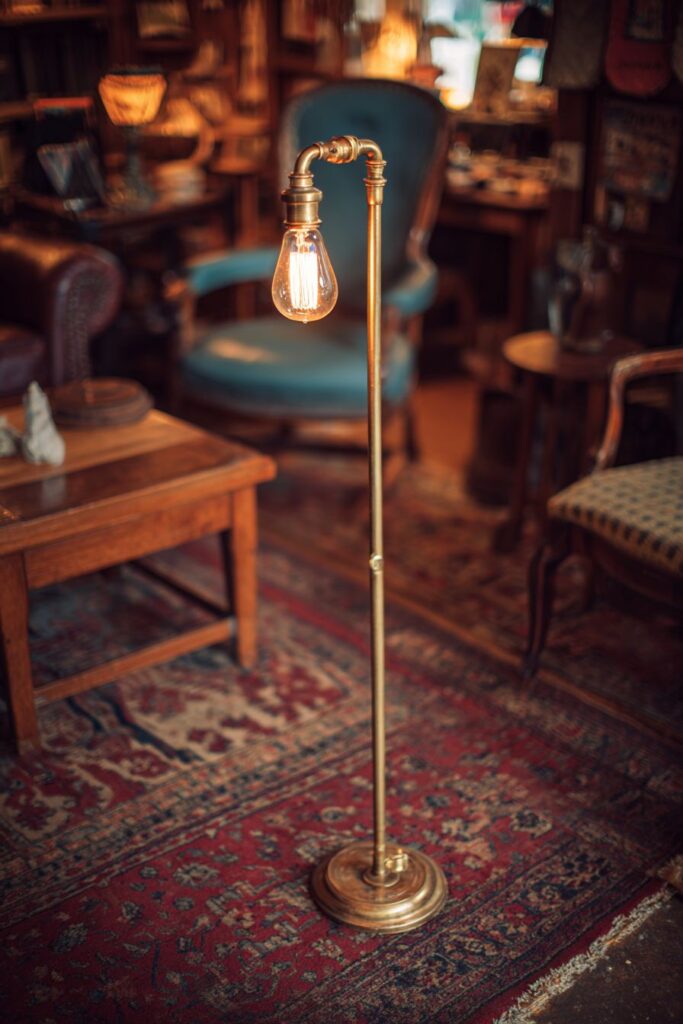
Eclectic interior design celebrates the art of mixing different periods, styles, and influences to create unique spaces that reflect personal history and collecting passion. A vintage-inspired floor lamp with aged brass finish and Edison bulb positioned among an eclectic mix of antique and modern furniture demonstrates how lighting can serve as a unifying element that brings disparate pieces together. The weathered patina adds authenticity while creating visual connection to other aged elements throughout the space.
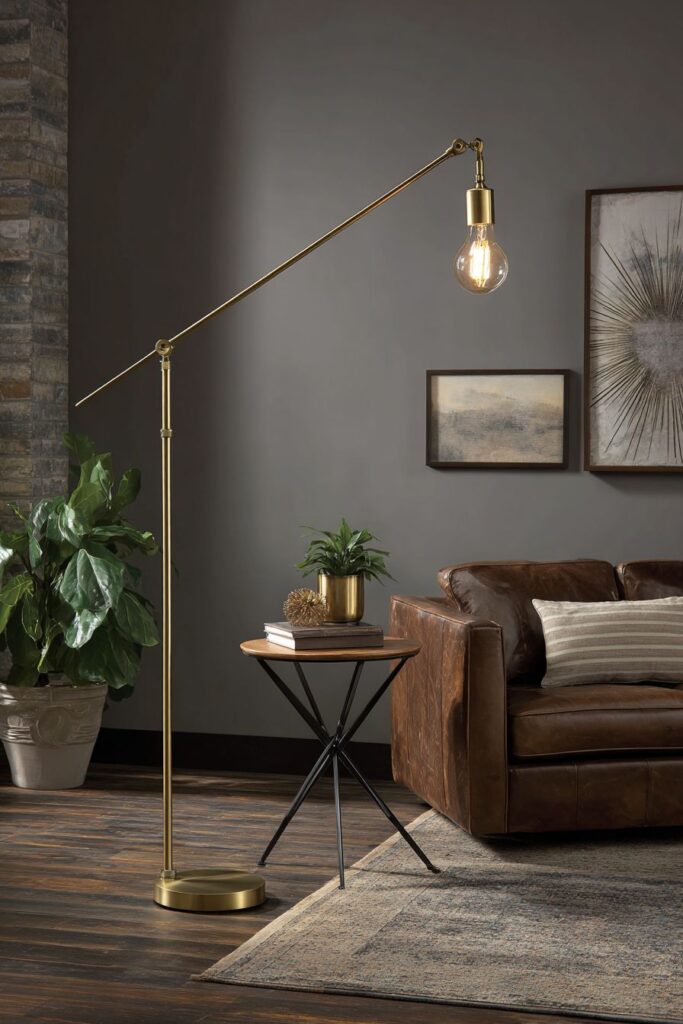
The mixture of worn leather chairs, vintage Persian rugs, and collected artwork spanning different eras requires careful curation to achieve harmony rather than chaos, with lighting serving as one of the key elements that can unify diverse pieces. Hardwood floors with natural wear patterns add authentic character that cannot be replicated through artificial aging, their imperfections telling stories of years of use and care. This patina of age provides the foundation that makes collected pieces feel authentic rather than merely decorative.
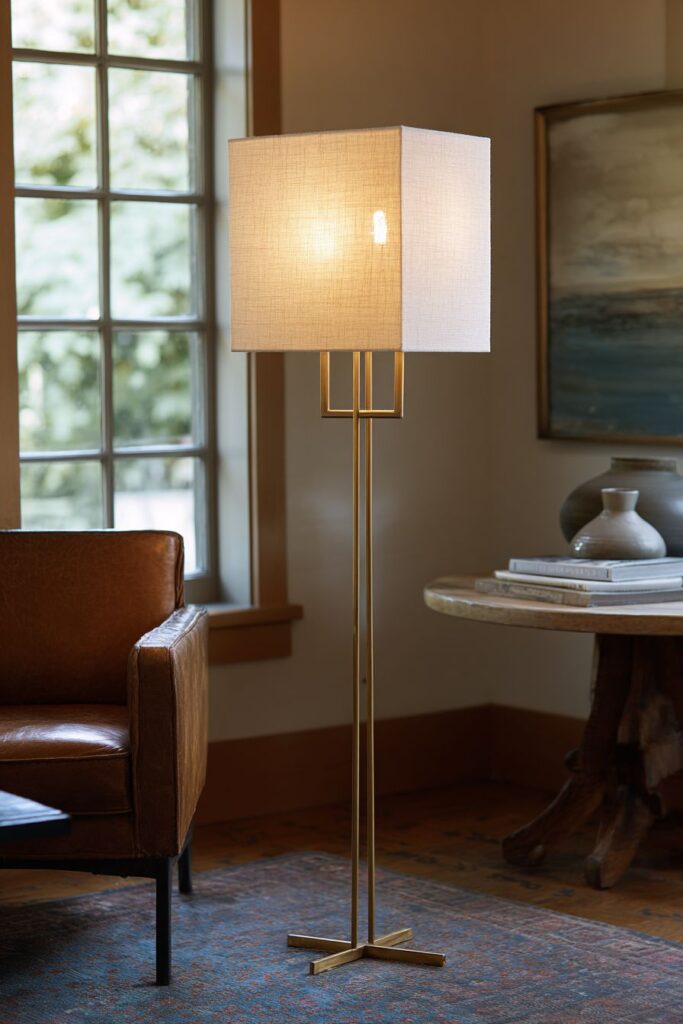
Successful eclectic design requires understanding how different periods and styles can complement each other, often through shared color palettes, material choices, or design proportions. The vintage lamp’s nostalgic charm provides warmth and character while serving as conversation starter that reflects the owner’s appreciation for design history and craftsmanship. These authentic pieces develop character over time, becoming more beautiful and interesting with age and use.
Professional photography of eclectic interiors often emphasizes the layered complexity that makes these spaces so visually interesting, capturing how different periods and styles can work together when unified through careful curation and thoughtful placement. The warm Edison bulb illumination enhances the aged character of vintage pieces while providing comfortable lighting for modern living needs.
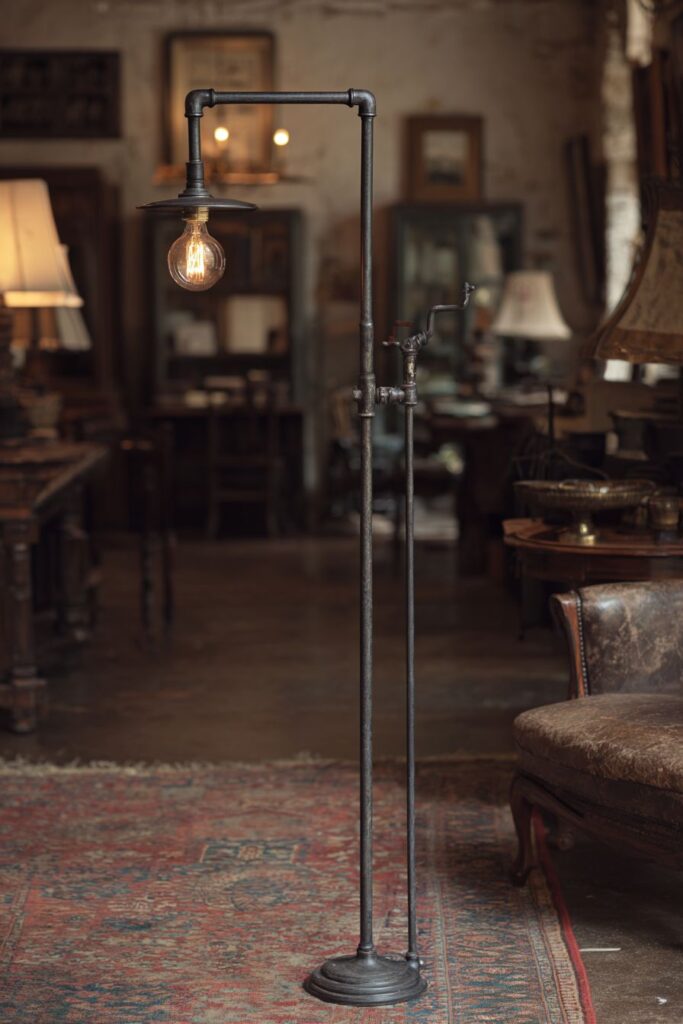
Key Design Tips:
- Collect pieces from different periods but maintain some unifying elements like color or material
- Allow authentic wear and patina to show rather than refinishing vintage pieces
- Layer lighting sources to highlight different collected pieces throughout the space
- Balance old and new elements to prevent the space from feeling like a museum
- Display collections thoughtfully to tell stories about personal interests and travels
19. Open-Concept Versatility with Zone Definition
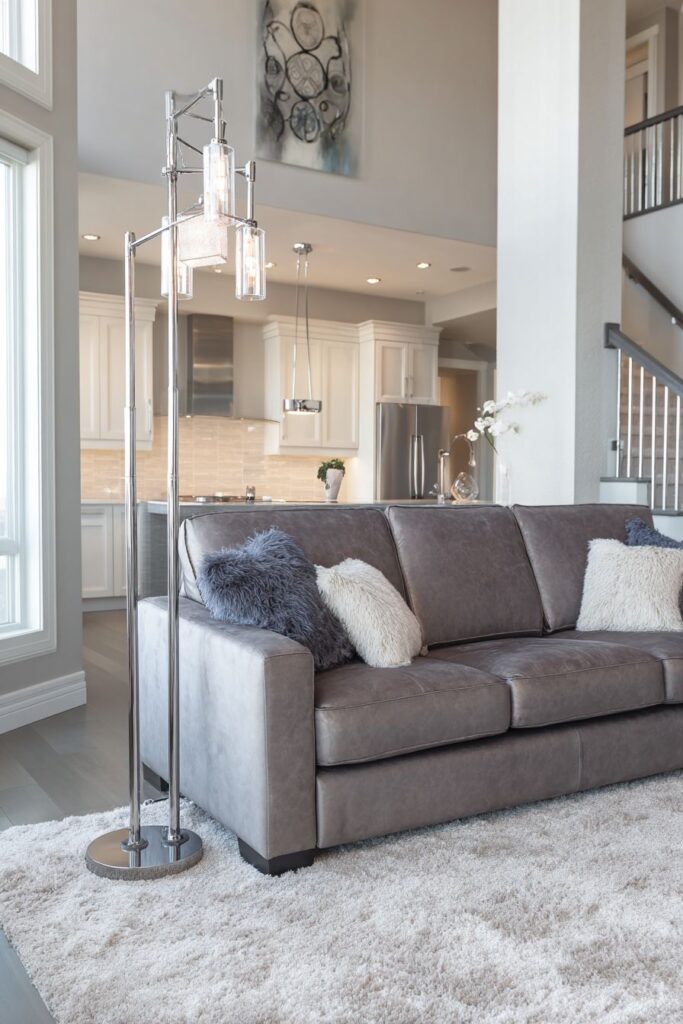
Open-concept floor plans require thoughtful lighting design to create functional zones within continuous spaces while maintaining the sense of openness that makes these layouts so appealing. A tall floor lamp with multiple light sources providing both uplighting and task lighting demonstrates how strategic lighting placement can help define different areas within a great room. The contemporary fixture with adjustable LED panels offers flexibility to meet various lighting needs throughout the open space.
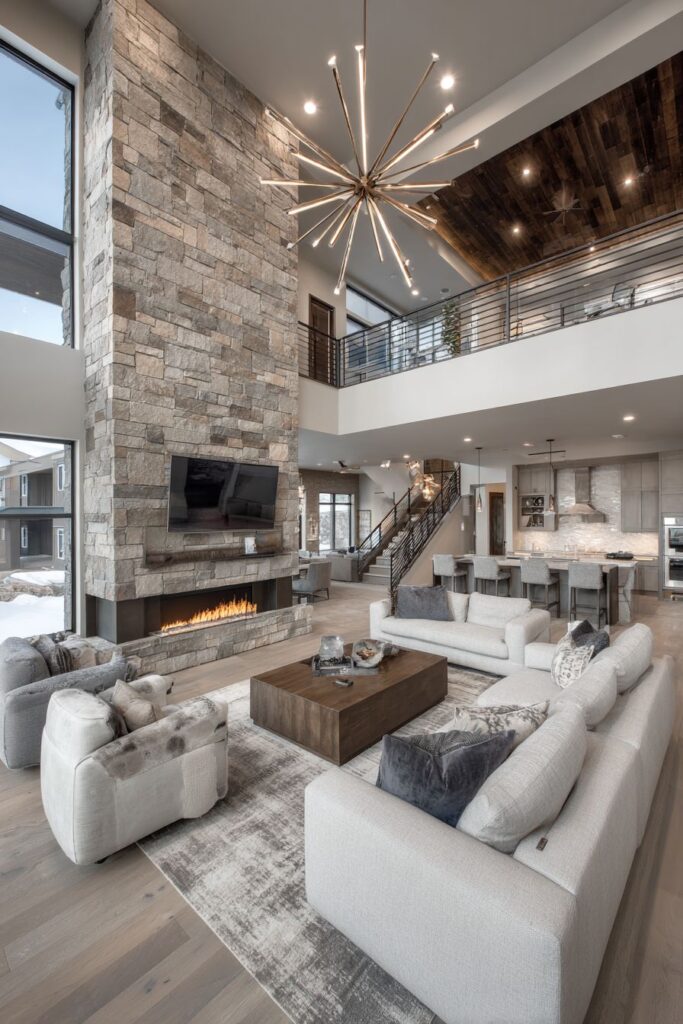
Modern furniture in neutral tones maintains visual flow throughout the open floor plan while allowing the lighting design to take precedence in defining functional zones within the larger space. The consistent color palette prevents visual fragmentation while providing a sophisticated backdrop that allows architectural elements and lighting fixtures to stand out. Glass and metallic elements reflect light throughout the space, helping to distribute illumination evenly while adding sparkle and visual interest.
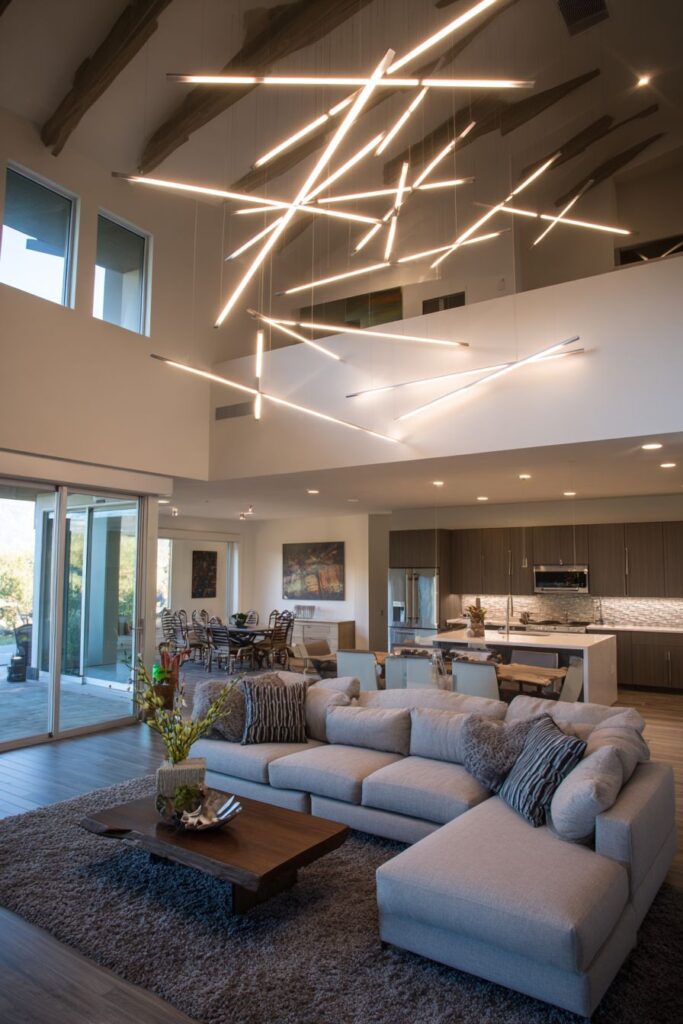
The challenge of open-concept lighting lies in providing adequate illumination for different activities while avoiding the creation of harsh boundaries that destroy the sense of spatial flow. Multiple light sources within a single fixture address this challenge by offering flexibility to adjust lighting levels and directions based on current needs and activities. This adaptability makes open-concept spaces truly multi-functional throughout the day and evening.
Wide-angle photography of open-concept spaces demonstrates how strategic lighting placement can create definition without sacrificing the sense of openness that makes these floor plans so desirable. The interplay between different lighting sources creates depth and visual interest while ensuring comfortable illumination levels for various activities from cooking and dining to relaxation and entertainment.
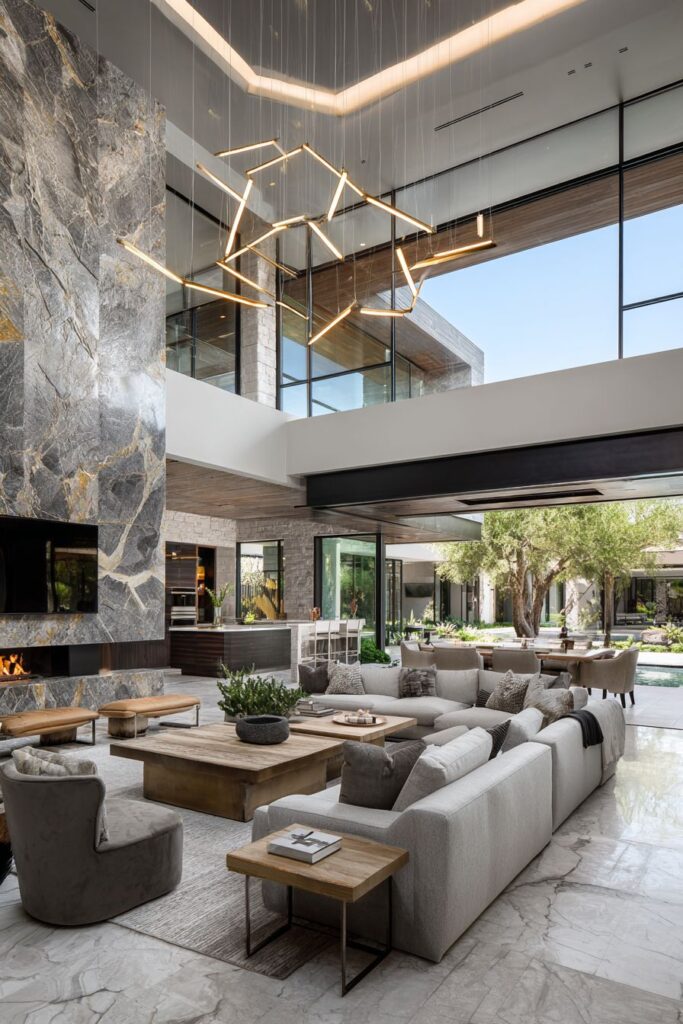
Key Design Tips:
- Use lighting to define functional zones within open floor plans without creating visual barriers
- Select fixtures with multiple adjustable light sources for maximum flexibility
- Maintain consistent color palettes to ensure visual flow throughout open spaces
- Consider how lighting reflects off surfaces to distribute illumination evenly
- Plan lighting schemes that accommodate different activities within the same space
20. Timeless Neutral Elegance with Sophisticated Simplicity
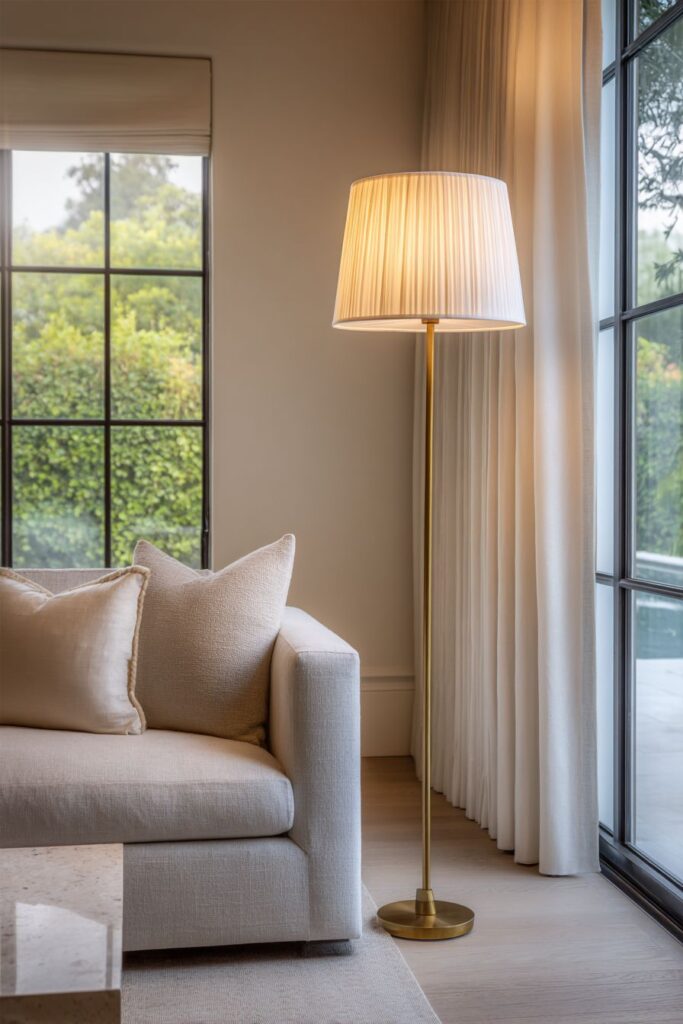
Neutral color palettes create sophisticated, timeless interiors that serve as perfect backdrops for quality materials and expert craftsmanship. An elegant brass floor lamp with white pleated shade positioned beside a neutral-toned sectional sofa demonstrates how classic combinations can create lasting beauty that transcends passing trends. The warm metallic finish adds richness to the neutral palette while maintaining the sophisticated restraint that defines timeless design.

Cream and beige furnishings with natural linen textures create layers of subtle variation within the neutral palette, their organic qualities adding warmth and interest without disrupting the serene atmosphere. The pleated shade provides textural interest while diffusing light beautifully, creating soft illumination that enhances the natural materials throughout the space. A travertine coffee table adds organic texture while maintaining the neutral color scheme, its natural stone surface providing subtle color variation and authentic material beauty.
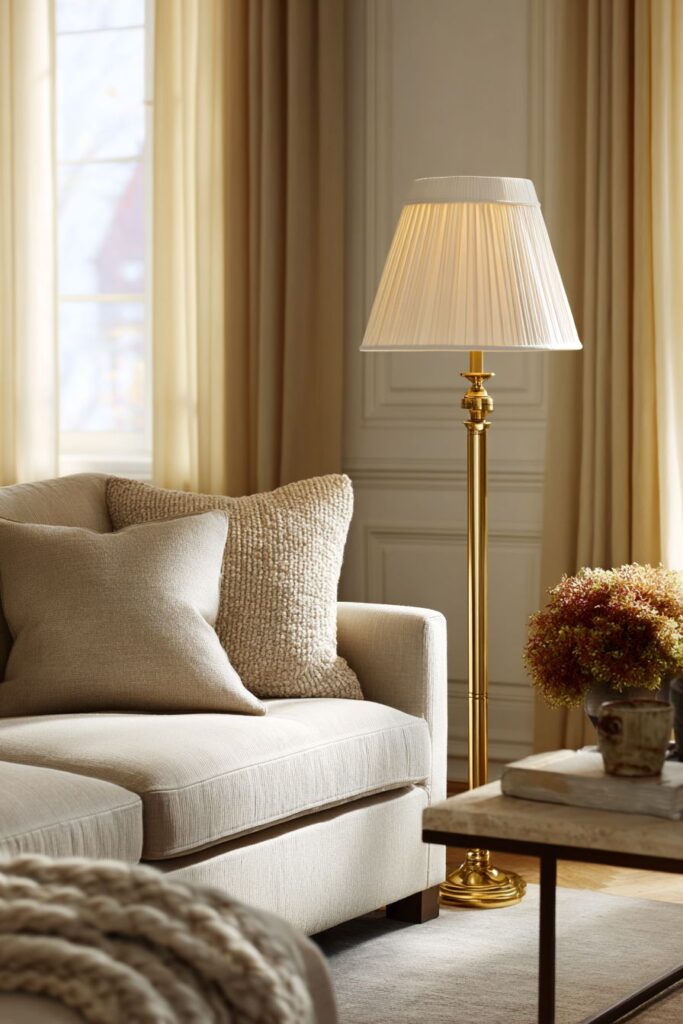
Soft wool area rugs add comfort and warmth while defining seating areas within the larger space, their natural fibers and neutral tones complementing other organic materials while providing necessary softness for comfortable living. The layered textures of linen, wool, travertone, and brass create visual and tactile interest within the restrained color palette, demonstrating how neutral schemes can achieve sophistication through material quality rather than color contrast.
Professional photography with soft golden hour lighting showcases how neutral interiors can be both sophisticated and welcoming, the brass lamp’s warm finish catching and reflecting natural light throughout the day. This interplay between natural and artificial light sources creates dynamic conditions that highlight the subtle beauty of neutral materials and textures while maintaining the calm atmosphere that makes neutral interiors so enduringly popular.
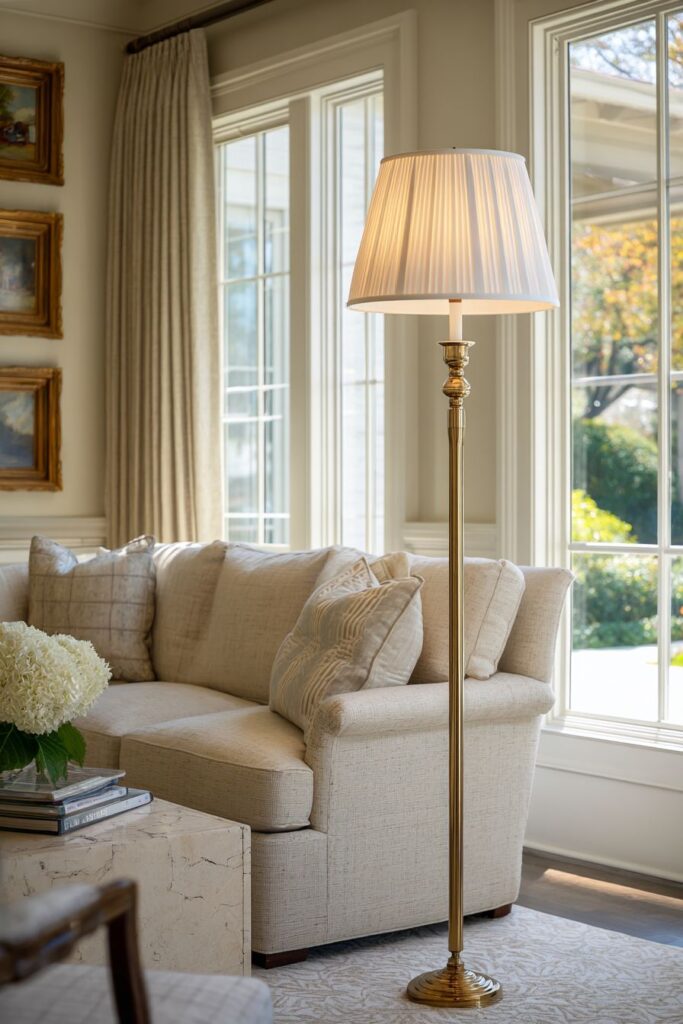
Key Design Tips:
- Layer different textures and materials within neutral color palettes for visual interest
- Choose quality materials like brass, linen, and natural stone for authentic beauty
- Use warm metallic finishes to add richness without disrupting neutral schemes
- Consider how different lighting conditions affect neutral colors throughout the day
- Focus on material quality and craftsmanship rather than bold colors for lasting appeal
Conclusion
Floor lamps represent one of the most versatile and impactful elements in living room design, offering unlimited possibilities for combining functional lighting with aesthetic expression. From sleek contemporary arc lamps to handcrafted rustic fixtures, each style speaks to different personalities and lifestyles while addressing the fundamental need for comfortable, attractive illumination in our most important gathering spaces.
The twenty design concepts explored in this article demonstrate how thoughtful selection and placement of floor lamps can transform ordinary living rooms into extraordinary spaces that reflect personal style while meeting practical lighting needs. Whether you’re drawn to the clean lines of Scandinavian minimalism, the raw authenticity of industrial design, or the opulent glamour of Art Deco-inspired pieces, the right floor lamp can serve as both functional necessity and artistic focal point that anchors your entire design scheme.
As you consider incorporating these ideas into your own home, remember that successful lighting design requires understanding how different sources work together throughout the day and evening hours. The best floor lamp choices will complement your existing architectural features, furniture selections, and lifestyle needs while providing years of reliable performance and enduring beauty. Take time to experiment with different positions and lighting combinations to discover the perfect solution that makes your living room truly shine.
